Darkest Days by Dates Down Under: Part 5
Accommodating France — Rainbow Warrior Bombing, 10 July 1985
➳ This "Darkest Days by Dates Down Under" series explores how New Zealand’s crises are thematically encoded with historical riffs to signal authorship, cooperation, scapegoats and caution — while telegraphing hidden objectives.Introduction
The French DGSE’s bombing of the Rainbow Warrior, at Marsden Wharf in downtown Auckland on July 10 1985 is most remembered as a bungled operation blown open.
Greenpeace planned to sustain a protest flotilla at Mururoa Atoll to frustrate France’s nuclear testing program. Yet, while sinking Greenpeace’s Pacific flagship was the immediate objective, there was also a chilling threat packaged into the bomb plot.
The over-arching purpose of the secret mission was to convey a ‘Morse Code’ warning to Western Elites. A key feature of covert operations is codified symbolism.
The French DGSE stayed at a motel unit owned by David Lange, the prime minister.
Two of the terrorists — Major Alain Mafart and Captain Dominique Prieur, who posed as Swiss honeymooners ‘Alain and Sophie Turenge’ — were detained near Auckland Airport on July 12 after waiting for a $130 refund on a rented Newman’s camper-van, amid news that a Police hunt was underway to catch the perpetrators.
Rainbow Warrior photographer, Fernando Pereira, drowned while retrieving his cameras when he became trapped below a collapsed stairwell after a second magnetic limpet mine, placed on the propeller turbine assembly, exploded four minutes later.
Yet, a theatrical quality underscored three entwined political conflicts — the U.S. nuclear powered and armed vessels, the ANZUS military alliance, and the bombing of Greenpeace’s Rainbow Warrior. Former Auckland Star paper-boy, Steve Snoopman finds this theatre was encoded with a ‘price of power’ theme, featuring an ensemble cast of characters who appeared to perform to sub-plot scripts, riffing off historical events, however aware or not, as if they were directed by Shakespearean and Voltairean ‘playwrights’ who had an inside track to the secret wills of ‘the few’.
It appears the Opération Sataniqué bomb mission to sink Greenpeace’s Pacific Ocean flagship, Rainbow Warrior on 10/7 in 1985, was intended as a dues ex machina plot device to resolve a narrative impasse, whose tangled lines extended back to the 1970s.
Derived from Greek and Roman theater, a Deus Ex Machina (or god from the machine) is a plot device that unexpectedly resolves a deadlocked conflict, by the sudden appearance of an implausible character, object, event, power, or action.
France’s equivalent of the CIA, the Direction Générale de la Sé-curité Extérieure (DGSE), was ordered to sink the Rainbow Warrior to wreck its plans to act as a ‘mother ship’ for an anti-nuclear peace flotilla at Mururoa Atoll, during another round of tests.
Yet, New Zealand was also chosen as a location for the attack. The prima facie evidence indicates the over-arching objective was to persuade Lange’s Cabinet that they were better off staying inside ANZUS and the Western Alliance, in a cruel world where the perpetrators remained uncertain, or unprovable beyond reasonable doubt. Since the mission planning was rushed, and the DGSE made critical mistakes, and panic set in even before the bombs exploded, the ANZUS rift widened into a chasm.
One of the enduring mysteries of the provocatively named mission, was why exactly was the dive team ordered to set a very short delay on the detonator timers. The three hour delay on two magnetic limpet mines was barely enough time for the DGSE agents to flee the operational area. It also required agents to lay low in New Zealand.
This ground-breaking dispatch is packed with historical riffing so explosive, that Snoopman believes it reveals the ‘matrix code’ used by transnational deep state networks to signal their chess moves to one another as a looming season of hostilities approaches, and into the aftermath to control the damage as allegiances are jolted.
As a modus operandi, such historical riffing signals authorship, cooperation, caution and to telegraph objectives. The signals indicate players are communicating their cooperation to take a plot ‘live’, convey hidden objectives, and to broadcast psychotic humour, thereby posting themselves like hostages — as applied game theory predicts.
In this “Darkest Days by Dates Down Under” series, Snoopman surveys the curious coincidences of calamities, catastrophes, or crises that jolted the nation while power, wealth and control were accumulated. In this disturbing multi-decade sketch, Snoopman traces the creepy trail of spooky minds, who he believes plot machinations with an eye on the past and a dark vision of the future. The circumstantial evidence reveals an awful picture of each new administration becoming embroiled in a cover-up of a staged event made to appear as an accident, a natural disaster, or a crisis caused by an unhinged man, or an ‘unsolved’ crime. The modus operandi of metaphor laden-historical riffing continues because most monkeys suffer from symbol illiteracy.
Since this proven case of state-sponsored terrorism features the uncanny coincidence of metaphor-laden historical riffing and contains themes of sovereign power, accomodating competing political interests, and the paying of dues to alliances, Snoopman contends it would be possible to apply mathematical equations to test the probabilities of chance, and to determine the over-arching objectives of the ‘conflict’.
Although this proven mission of state-sponsored terrorism went awry and became a tragic-comic opera featuring a fuming fat man, it also breached a rule of story telling.
A story can begin with a coincidence, but it can never end with one.
Yet, as Snoopman shows, the messy aftermath stage — which required a U.N. sponsored resolution — also contained the same historical coincidences, because the perpetrators required rescuing, while the targetted state needed to save face.
In this inverted upside down world — that features an accommodation theme that was packaged with a sinister twist — an intriguing ‘blueprint’ emerges. Copied chess moves are countered with themed historical riffs that seem too uncanny to be mere chance. The political move of New Zealand’s Prime Minister David Lange to advance Prime Minister Norman Kirk’s anti-nuclear legacy, was taken as a direct affront not only to France’s nuclear testing in the Pacific. But, also to the plans of François Mitterrand and his friend, Charles Hernu, the Defense Minister, who were set on constructing a naval base and air force base in French New Caledonia. New Zealand’s proposed Nuclear Free legislation envisaged not only declaring the country a nuclear free zone. But also, to lobby Pacific nations to declare the South Pacific nuclear free.
Ergo, a collision of political ideas exploded late on July 10 1985. This dispatch seeks to answer why exactly the bombing occurred that evening, despite the Rainbow Warrior’s scheduled departure being publicized as July 23, after resupplying the vessel.
This dispatch traces the intriguing tale of planned and improvised chess moves as tempers fray, strategies fall apart, friends fall out, and while alliances collapse.
➳ Key Findings: The date correspondences indicate signals intelligence of a looming terrorism plot, that appeared designed to persuade the Lange Cabinet of the need to find a way through the anti-nuclear impasse. Since the culprits behind the bomb plot were supposed to get away, and remain unknown to all but the ‘spooks in suits community’, it seems the French intended to jolt the center of political gravity in Wellington back into the orbit of the ANZUS military alliance, and by default the Western Alliance. But since this plot went awry when two agents were caught shortly afterward, the damage control in the messy aftermath also required a theatre of events featuring historical riffing to signal cooperation, caution, threats and scapegoats.
Rainbow Warrior Bombing, 10 July 1985 — Death Toll: 1
On 10 July 1985, while New Zealand was in the midst of re-inventing itself as a model corporate-state, the French DGSE sank Greenpeace’s Pacific flagship, the Rainbow Warrior at Marsden Wharf in Auckland. The 130-ft vessel had been refitted with a radio mast capable of transmitting pictures, and able to act as a ‘mother ship’ for a protest flotilla for an upcoming 150-kiloton French nuclear test at Moruroa Atoll.
New Zealand’s Labour Party, led by the rotund Methodist ex-lawyer, David Lange, had made a number of chess moves prior to the bombing that were provocative to France.
Mitterrand and Hernu planned a military base in French New Caledonia with a huge runway, and with a 300 metre wharf at a nearby bay to accommodate naval vessels, including nuclear submarines. Such a base would support the American Empire’s presence in the Pacific, to counter the Russian Soviet Empire’s influence in the region.
The Labour Party Executive made a decisive political chess move in May 1984, when it released its foreign policy. If elected, the party would legislate to make New Zealand nuclear free, which meant banning nulear power and nuclear armed vessels. And the Labour Government would also promote a South Pacific Nuclear Weapons Free Zone, and end nuclear waste dumping and nuclear weapons testing in the Pacific.
Two weeks later, Richard Prebble, a right-winged Labour front-bencher, introduced the Nuclear Free New Zealand Bill into Parliament. The bill was narrowly defeated in a vote, 40-39, on June 12 1984. Since it was Prebble’s fifth attempt at getting the bill passed, the Auckland Central MP could be counted on to submit it once again at a time when Muldoon was sensing he was up against the political boxing ropes. Indeed, Muldoon had confided to Lord Carrington, the British Foreign Secretary, that he might have to go the country early for an election in March or April 1985. It is well known that the vote over the Nuclear Free Bill caused Muldoon to have to gain votes from two renegade Labour Party politicians to stave off New Zealand being declared a nuclear free zone, and that two days later on June 14, Muldoon called a snap election.
The date June 14 was shown to have carried a historical potency in part 4 of this Darkest Days Down Under series. On June 14 1942, the U.S. 1st Marine Division arrived in Wellington. Numerous U.S. ships arrived in 1942 and 1943, to build camps, roads, airfields, tunnels, bunkers and gun pillboxes around the country, with an underground headquarters in Epsom. Were Muldoon’s ruffled feathers plucked?
The date of the vote also carried a provocative potency for France, since it appeared to riff off the infamous demise of the French Captain Marc Joseph Marion du Fresne, and 27 of his men, who were murdered by a local tribe, Ngare Raumati, at Oraukawa Bay, Moturoa Island in the Bay of Islands, on 12 June 1772. During the War of the Austrian Succession, Marion du Fresne captured several English ships and aided in the rescue of Prince Charles Stuart from Scotland in 1746, a feat for which the French Navy made him lieutenant commander, after his release in a prisoner exchange.
Moreover, on June 12 1902, New Zealand’s flag — which was coloured in with a blue ensign — was confirmed. This New Zealand flag had been adopted for use on government ships since 1869, and was proclaimed as “the recognised flag of the colony for general use on shore within the colony and on all vessels belonging to the Government of New Zealand”. And on June 12 1942, the first U.S. troops arrived in Auckland Harbour, to assist in laying numerous concrete roads near military camps, barracks and airfields, while gun emplacements were built around the coastline, and underground bunkers and tunnels were constructed, some utilizing the natural volcanic caves and caverns, to create invasion shelters and a command headquarters.
Labour won the ‘Bastille Day’ snap election of July 14 1984. Helped by a capitalist coalition — whose support amplified a remarkable swing of votes — Labour came within 400 votes of winning Muldoon’s ‘true-blue’ Remuera electrorate, comprised of posh suburbs: Parnell, Remuera, Orakei, Mission Bay, St Heliers, and Kohimarama.
In effect, Bob Jones became the Ernest Rutherford of New Zealand politics, since he founded the center-right New Zealand Party in 1983 to split the atomic vote of the National Party, and to gift Lange’s Labour Party enough margin to win the election. The ‘business community’ knew the mind of the incoming Finance Minister, Roger Douglas, who intended to lead the restructuring of New Zealand to forge a ‘market economy’. Ergo, Richard Prebble became the Julius Robert Oppenheimer of politics, since he set off a political chain reaction that altered the course of New Zealand.
The U.S. Secretary of State, George Schultz, who had watched the election night results coverage from across the Tasman with Australian Prime Minister Bob Hawke, landed at Ohakea Air Force Base to perform the function of the political equivalent to a morning-after pill. Schultz attempted to lean on Lange to bring the public around to the idea of American ship visits, in the wake of the backlash to nuclear power, and to the Muldoon-era armed ship and submarine visits. Schultz — whose German and Dutch derived surname, from Schultheiß, meaning village headman, constable, or sheriff in the medieval sense — came over acting like he was a Wellington Alderman. Schultz would later claim he gave David Lange six months to shift public opinion.
Wellington-based journalist Nicky Hager, reported that he has learned from once-secret documents released over the decades since, showing that New Zealand officials from Defence, Foreign Affairs and the prime minister’s department all told Lange and other ministers that it would be possible to have a strict ban on nuclear armed and powered warships and to stay in the military ANZUS alliance. The officials told them that they could negotiate a diplomatic solution with the Americans that honoured Labour’s nuclear-free policy. Meanwhile, these officials set out to undermine the nuclear-free policy, working out a plan in the latter months of 1984, Hager wrote:
“In private, there was an understanding at the heart of the negotiations: that New Zealand would offer the Americans what the Secretary of Foreign Affairs, Merv Norrish, called ‘step-by-step progress towards an accommodation’, starting with ships less likely to be nuclear armed during the visit and moving towards what was called ‘normal port access’, including inevitably nuclear armed warships. The New Zealand position ‘may well have to incorporate an element of trust,’ Norrish told his colleagues.” — Nicky Hager, Nov 5 2023
Secretary of Foreign Affairs, Merwyn Norrish, along the Chief of Defence Staff, Ewan Jamieson, the Secretary of Defence, Denis McLean, and the head of the prime minister’s department, Gerald Hensley, formed an informal group of pro-ANZUS military alliance officials, who set out to undermine Labour’s nuclear-free policy.
Hager said these men were the greatest opponents of the Lange Government.
In December 1984, in an apparent attempt at appeasement, Lange sent Chief of the Defence Force, Air Marshal Sir Ewan Jamieson, to Honolulu to choose the ship with the U.S. Pacific Command. Air Marshal Jamieson settled on the USS Buchanan. This near-obsolete destroyer was subsequently decommissioned in 1991, and while capable of carrying nuclear weapons, it was construed that it almost certainly would not have been, and had recently visited Japan, where there was also a strong anti-nuclear movement. However, Japan’s Nuclear Free Zone stance was a sham. Hager said a ‘wiggle room’ plan developed in 1984 between U.S. and N.Z. officials, to soften the public over a period of years. Shrouded in vagueness, vessel visits would start with a status, deemed ‘unlikely’ to be nuclear powered, ‘nor likely’ to be nuclear armed.
On January 17 1985, the U.S. Embassy resubmitted a request for a visit by the destroyer, USS Buchanan, as then-head of the Prime Minsiter’s Department, Gerald Hensley recounted in Friendly Fire: Nuclear Politics & the Collpase of ANZUS, 1984-1987.
This date was politically potent because on January 17 1853, Governor Sir George Grey issued a proclamation to bring the New Zealand Constitution Act (UK) 1852 into operation, establishing a system of representative government for the colony. As I noted in part 4, a system of ‘responsible government’ was established, meaning the government can only be made up of Ministers who are first elected members as the House of Representatives. The government only stays in power while it has a majority of members in the House of Representatives, a West Minister-style Parliament. Ergo, the state managers around Lange et al were reminded about ‘responsible government’.
In late January 1985, while Lange was on a long-scheduled visit to Tokelau, future PM, Helen Clark, who was a key political player in the Labour Party’s anti-nuclear faction, pushed for shutting out American ship visits. But, the forcing of the issue while Lange was in Tokelau, did not come from Lange’s colleagues. The timing of the request was forced by the Americans “to pull the rope from under me”, Lange himself maintained.
This critical January 28th cabinet meeting was potent because the date coincided with two important dates in New Zealand’s maritime history. On January 28th 1827, French naval captain Dumount D’Urville sailed the Astrolabe through a riptide passage, later called French Pass. After five days of attempts, dare-devil D’Urville entered Admiralty Bay. And, on January 28 1879, the Government accepted a tender for the Auckland Harbour reclamation project, which meant Commercial Bay was filled in and wharves were built for a port. These uncanny historical riffs acted like a foreboding omen, as if signalling the ANZUS rift could snowball. When it did, the French DGSE paramilitary wing inflicted an operation on Auckland Harbour and even stayed at the prime minister’s motel unit, as like a threat for accommodating the anti-nuclear movement.
Hager — who at the time was the head of the Coalition Against Nuclear Warships —was telephoned by Frank O’Flynn, N.Z.’s Minister of Defence, to read his secret briefings over the weekend that Lange was in Tokelau. Hager recounted at a lecture in 2023, the Minister of Defence was in effect being steered to agree to the USS Buchanan visit. By a critical reading of the papers, Hager determined that there was a crucial sentence that he pointed out to O’Flynn, for him to take to Cabinet. Air Marshal Jamieson had written that he could “give no absolute guarantee that the ship does not carry nuclear warheads . . .” In effect, Hager offered a way out for Lange, that would also save face for the Americans. He suggested the Oliver Hazard Perry class option.
The CANWAR head — who was instrumental in organizing opposition to the nuclear powered cruiser USS Truxton to Auckland and Wellington harbours in 1983 — had created a list of all the U.S. nuclear warships and submarines that were banned from New Zealand under the nuclear-free policy. Hager recalled one modern class of guided missile frigates that had no nuclear weapon systems: the Oliver Hazard Perry class.
Hager explained to O’Flynn that once NZ steps on the slippery slope of allowing a ‘not very likely’ nuclear armed ship to visit New Zealand waters, a succession of warships and submarines could come, each progressively ‘more likely’ to be nuclear armed. And then, New Zealand would have a sham Nuclear Free Zone status — like Japan.
Buchanan was capable of launching nuclear anti-submarine rockets (or depth bombs).
It turns out that how Hager came to be New Zealand’s informal foreign policy advisor for one weekend in January 1985, was because Frank O’Flynn was pacing around at home, stressed that he didn’t have anyone to turn to, while Lange was out of the country. O’Flynn needed someone he could trust to read over the top secret papers, to help him make a wise choice, while not betraying the public will upon which Labour was elected. His daughter, Bridget, knew Hager from Victoria University. In this way, Hager’s suggested option to O’Flynn was recorded in the Cabinet meeting report stating that Lange told cabinet the Buchanan was not suitable and he intended to ask the Americans for another ship, one from the Oliver Hazard Perry class.
Nicky Hager became the Albert Einstein of New Zealand politics by indirectly warning Lange that the U.S. was developing a deceptive strategy; Hager’s intervention was explosive, and when it detonated, the ANZUS rift widened into an impasse.
Lange returned on January 28, and led his Cabinet to reject the move to allow USS Buchanan visit. Ergo, since the decison didn’t go the way that N.Z.s’ senior officials, Gerald Hensley, Ewan Jameison, Merwyn Norrish, and Denis McLean — wanted, the repercussions suggest that these officials were complicit in withholding intelligence from Lange’s Government about the impending French attack, as I show.
Hager stated that New Zealand Police and the Security Intelligence Service had undercover ‘radical agents’ infiltrate the anti-nuclear movement, including the Peace Squadron meetings, to gather ‘intelligence’ on the flotilla protests.On January 31st 1985, Senator William Cohen (Rep-Maine) wrote a letter to President Ronald Reagan expressing that the response should not be ‘delicate and diplomatic’.*
Not surprisingly, January 31st is a potent date in maritime history. On January 31 1770, Captain James Cook performed a discovery ritual on Motuara Island Queen Charlotte Sound, and with the Union Jack flag raised, the Freemason navigator proclaimed the island and the adjacent lands as possessions of King George III.
Crafty Cook gleaned information from Chief Topaa, and kin with him, as well as other Ngāti Kuia Māori on the Eastern shores of Queen Charlotte Sound, about another land to the South, meaning there was another strait. But, Cook fudged his chart and smudged his journal, to obscure Stewart Island and Fouveax Strait to hide the inlet that became a settlement and port at Bluff Harbour at the bottom of the ‘South Island’.
By hiding islands, for instance, off the coast of harbours, Cook was buying time for Britain to establish settlements, garrisons and ports. Captain Cook had charted the jaggedy coastline of Newfoundland with the forebearance that the French could mount attacks after they were given nearby islands, St. Pierre and Miquelon. This wisedom sprang from a shadowy figure, Phillip Stephens, Secretary of the Admiralty for thirty-two years, de facto chief of the Secret Service and architect of empire.
And on January 31st 1954, Queen Elizabeth II and Prince Phillip reportedly left Bluff at the conclusion of their first royal tour of N.Z. Perhaps, the new British Monarch was signalling the double entendre of the name Bluff. Aside from it’s obvious meaning as a hill or cliff facing a body of water, Cook’s maps were deceptive; historians maintain an ‘eyes wide shut’ policy to win dumb British chivalrous awards, I contend.
Thus, the historic departure at Bluff by Queen Elizabeth and the Duke of Edinburgh at the conclusion of their first royal tour (or landlord inspection) of New Zealand on January 31st 1954, was also historically potent. After all, Cook was to supply King George III with a full set of maps, as well as the Admiralty. Indeed, Cook was acting in accordance with the British Admiralty’s secret instructions to claim new territories for the British Empire. These secret instructions were not declassified until 1928.
In any case, their departure from New Zealand on the anniversary of Captain Cook claiming possession after he had confirmed with locals there was a strait between two large islands, and another large island to the south, signified the Royals were keeping up the Monarchy’s sovereign title claims with a nationwide landlord inspection.
NZ History has the royals leaving Bluff Harbour aboard the SS Gothic at end of their first landlords’ visit, on January 30, and visiting the remote Milford Sound, Fiordland, on January 31 before departing New Zealand the same day. 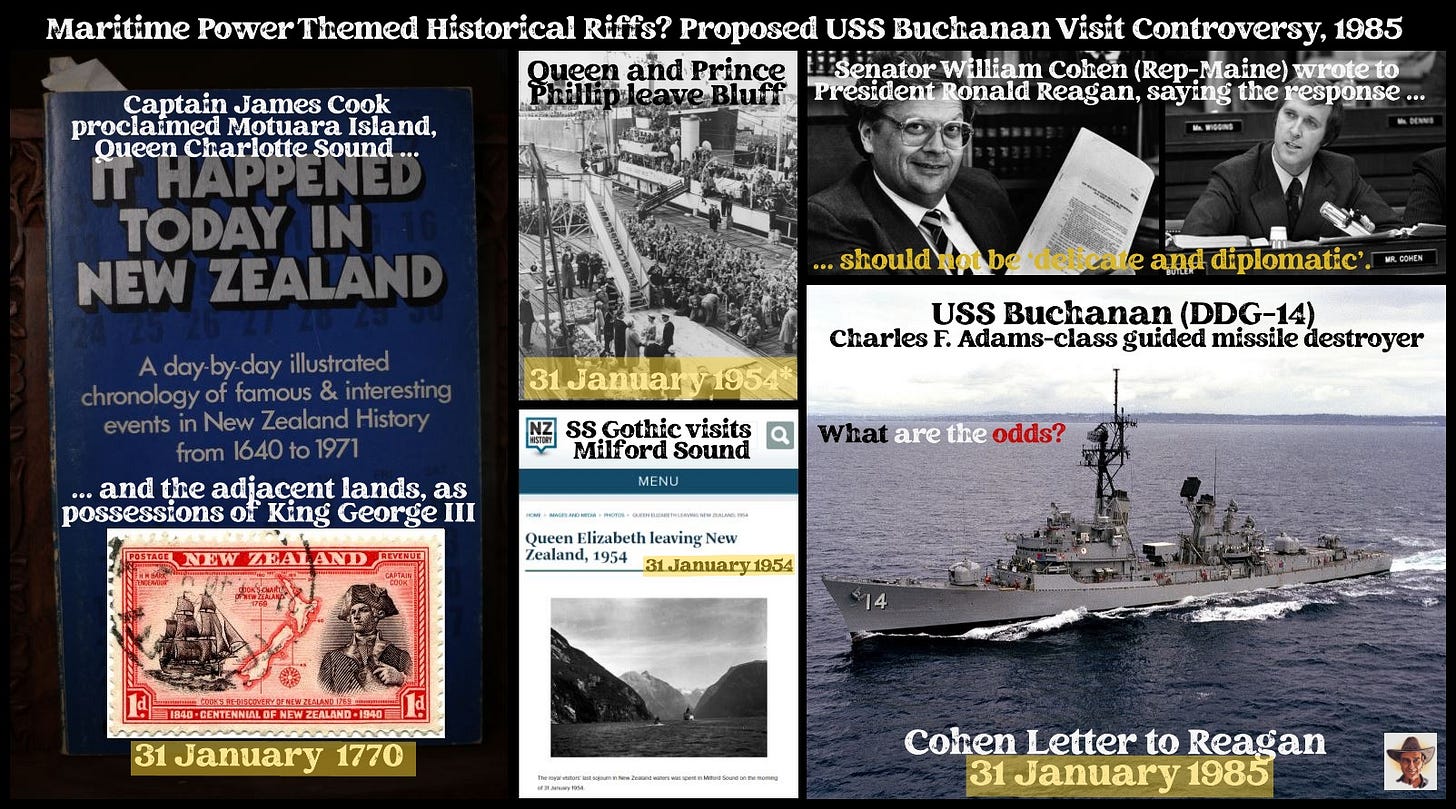
In his book review of Lying for the Admiralty (Margaret Cameron-Ash, 2018) — that proves Captain James Cook fudged his charts, smudged his journals, to hide habours, islands, and straits — Paul Brunton, the eminent curator of the State Library of New South Wales, stated that the documentary evidence needed to be assessed in light on their context. “In this, the author succeeds brilliantly,” he wrote. And, former Australian Secret Intelligence Service (ASIS) intelligence officer, Warren Reed, in writing his favourable review of Lying for the Admiralty, remarked that it takes a forensic tenacity coupled with impressive powers of deduction, of someone like Margaret Cameron-Ash, to re-examine the trail of events recorded in archives to provide a coherent picture of what really happened — centuries later. Secret matters go unwritten. On February 4th 1985, New Zealand sent a rejection letter regarding a visit of the USS Buchanan, a guided missile destroyer from Pearl Harbor. This was a politically potent date, too. On February 4 1944, units of the New Zealand Division relieved U.S. Forces in the attack on Cassino, Italy, and this relief operation continued into February 5.
The Labour Government’s sending of the USS Buchanan rejection letter on February 4th 1985, was also a potent date in Washington political circles. Every year on February 4, a National Prayer Breakfast convention is run by The Fellowship, also known as The Family, which is a syndicate that uses the cover of Christianity as a global political and economic network to penetrate the power structures to advance the interests of the Anglo-American Empire. Evidently, the great powers that comprise the Anglo-American Empire have fragile ego complexes, as if the heads of the collective ‘imperial brain’ are mentally ill and it is constituted with narcissistic sociopathic and psychopathic personality disorders. The ‘United States’ wasn’t happy.
On February 26th 1985, when Mr Lange reached Los Angeles, he was given a theatrical dressing down in Los Angeles. To add to the humiliation, the United States would not supply the former lawyer with a copy of the terms, and so the Methodist Prime Minister of New Zealand was theatrically reduced to the status of a sophomore law student taking notes with a pencil and paper, as the law was laid down to him in the style of a lecture-length excommunication, as former head of the Prime Minister’s Department, Gerald Hensley stated in his 2013 book, Friendly Fire about the ANZUS rift from 1984 to 1987. This occasion of the Under Secretary of State for Political Affairs, Bill Brown, presenting a narrative for the ex-communication at the Consul-General’s home in Brentwood, Los Angeles — appeared to riff off a dawn pistol duel.
A 19th century pistol duel at dawn between two lawyers, Harold Ross and William V. Brewer took place on 26 February 1844, in Wellington, on Sydney Street, Thorndon. The duel followed a quarrel over a case in the Wellington County Court. Ross died slowly from a shot to the groin. Although several people witnessed the duel, the coroner’s inquest concluded that there was no proof as to who had inflicted the wound. And there began the long tradition of the colony’s coroners reaching a conclusion that only made sense if one squinted one’s eyes so hard, there wasn’t enough light reaching the eyeballs to see the closing of ranks among the witnesses.
After this lecture-length excommunication, Lange and his entourage were driven into the underground garage at the Ambassador Hotel. The security detail assigned to the Prime Minister insisted that he and his team be walked through the hotel kitchen where Robert F. Kennedy was assassinated. Hensley recalled Lange’s nervous jocularity. Years later, Lange confided that the hair on the back of his neck had risen in alarm. By leading Mr Lange through the hotel kitchen where Robert F. Kennedy was assassinated before he made a speech, an implied threat was communicated.
Ergo, the truth of whose decision it was to fire the shots at New Zealand was unclear.
The historical riffing of dates suggests there were ‘playwrights’ across the ANZUS alliance who had been conferring about the construction of a ‘theatrical wedge’.
In late September 1985, after Le Monde scooped the story about French DGSE divers setting the two limpet mines on the hull of the Rainbow Warrior, Paul Wolfowitz — who was an official in the U.S. State Department's East Asia Division — suggested to New Zealand's Deputy Prime Geoffrey Palmer, that perhaps “creative lawyers” might find a way through the impasse.(Gerald Hensley Friendly Fire: Nuclear Politics & the Collapse of ANZUS, 1984-1987, p.222) On March 1st 1985, Lange made history at an Oxford University debate over the nuclear issue, when he verbally duelled with Reagan’s friend, Jerry Falwell. Lange’s ‘uranium breath’ quip became ‘video tape evidence’ in the construction of the national myth that Lange was a champion for the nuclear-free cause — to re-win power in 1987.
This Oxford Union debate coincided with the anniversary of the formation of the New Zealand Division on March 1 1916, which followed their evacuation from Gallipoli in December 1915, with their Australian counterparts. These infantry divisions would be sent to the Western Front, to assist with the liberation of France from German forces.
In 1915, Winston Churchill, amid flak he copped as First Lord Admiral of the Royal Navy, for overseeing the military ‘disaster’ at Gallipoli, the 33° Freemason bragged with the epic grandiosity of a sociopath, that “Australia and New Zealand [were] smiting down in the last and finest crusade the combined barbarism of Prussia and of Turkey.” The brutal truth is a British Secret Élite devised the Gallipoli Campaign in the Dardanelles to sacrifice Australian and New Zealand men. Russian Tsar Nicholas II was promised the port city of Constantinople as a ruse to keep the Russians in the war on the Eastern Front.On May 15 1985, DGSE chief, Admiral Pierre Lacoste, says he personally gained President François Mitterrand’s authorization in Elysée Palace, for the neutralization project: ‘Opération Sataniqué’. The choice of timing for this meeting was politically potent, because on 15 May 1848, an immense crowd assembled at Bastille, Paris, and proceeded to the City Hall of the National Assembly, proclaiming an insurrectionary government. Yet, they were repelled by the National Guard. This has been described as a prelude to the great Communist Rebellion of June 1848 following the overthrow of King Louis Philippe in February, which ended the Orleans monarchy (1830–48).
The 1848 Revolution in France led to the creation of the French Second Republic, and the election of Louis Napoleon Bonaparte as president on December 10. In 1851, he declared himself President for Life. Since Louis Napoleon Bonaparte became the first president, second emperor, and last monarch of France in the cauldron of what was, in fact, part of a broader series of uprisings organized by the Grand Orient Freemasonry, under the leadership of the then-head of the Illuminati, Guiseppe Mazzini, it would appear that President Mitterand’s reception of Admiral Lacoste at Elysée Palace was codifying the meeting with historic potency to communicate that like Napoleon III, the political chameleon, Mitterand (who was known to the public as Le Sphinx) was about to show his true fascist colours to his Parti Socialiste. After all, an attack on Greenpeace in a country that voted in a left-wing party that campaigned to establish the South archipelago as a nuclear free zone, was consistent with the right-wing fascist ‘strategy of tension’ to inflict terrorism attacks like those of Operation Gladio.
The timing of the bombing, I contend, was designed to send a message to all intelligence agencies — who could readily decode the attack was a state-sponsored terrorist attack by the historical riffing, and determine its authorship. This time parameter, however, causally led to Major Mafart and his fake ‘Swiss wife’, Captain Prieur, being detained by New Zealand Police two days later. The DGSE dive team were ordered to set the two magnetic limpet mines to explode with a shortened three hour timer countdown. In 2015, French DGSE diver, Colonel Jean-Luc Kister, who set the two limpet mines, said that because they did not have the usual 24-hour or 48-hour delay afforded to agents to give them time to skip the country, the operation required the dive team [terrorists] to play their cover roles as skiing French tourists for 10 days.
There are also historically potent dates that Opération Sataniqué appeared to riff off.
In 1840, on the night of 10 July, French Navy Captain Charles François Lavaud arrived in the Bay of Islands in the French frigate, L’Aube. But, Lavaud was beaten in his mission to claim the South Island as a colony of France by the Royal Navy warship, HMS Britomart. Captain Lavaud stated in his report Akaroa, that Jean-Baptiste François Pompallier had advised him to press ahead and annex the South Island.
By daybreak on 11 July 1840, the presence of the French Navy in Russell was evident.
By dawn on 11 July 1985, predictably, New Zealand’s Royal Navy divers proved the Warrior was bombed. Ergo, as a proven case of state-sponsored terrorism, the Warrior bomb plot — that happened at a port located in a place once called Commercial Bay, in a harbour mapped by HMS Britomart — contains metaphor-laden historical riffing.
And, back in 1772, on 11 July, French naval officers aboard the Marquis de Castries and the Mascarin proclaimed possession of New Zealand in the name of King Louis XV.
A top secret report, written by an official at the New Zealand Security Intelligence Service, explained away the timing of the bombing as ‘Sod’s Law’. It turns out that the Lange Cabinet was due to meet on July 17th to make a decision on the establishment of a Terrorism Emergency Group (TEG), which had been recommended by the Officials Terrorism Committee in a paper submitted to the Cabinet Committee on Terrorism around July 2 of 1985. It meant the attack also conveniently happened before intelligence support staff were moved from the Police Headquarters to the Government’s Headquarters at the Beehive in Wellington. What are the odds?
This Terrorism Emergency Group was to be chaired by the Prime Minister, and would include Cabinet and Officials, and meet in the Civil Defence Command Headquarters.
Not surpringly, it appears the July 17 decision date was selected to signal that the investigations into a planned attack by the French would be controlled, since this date too, was marked by a French historical reference. On 17 July 1851, Bishop Pompallier became a naturalized British subject, according to It Happened Today in New Zealand.
Ironically, on 17 July 1863, the first battle of the Waikato War occurred at Koheroa Hills near Mercer, on the watch of Freemason Governor Bro. George Grey. Ergo, the colonial war to consolidate paper sovereignty with soil escalated in the Waikato on the date that the French Bishop — who had once advised a French naval captain to claim paper sovereignty over the South Island — became a naturalized subject of Queen Victoria. Therefore, the date correspondences indicate signals intelligence of a looming terrorism plot, that appeared designed to persuade the Cabinet of the need to find a way through the anti-nuclear impasse, since the culprits behind the bomb plot were supposed to get away, and remain unknown to all but the spooks in suits.
The chairman of New Zealand’s Intelligence Council, Gerald Hensley, who also just happened to be the Chairman of the Officials Terrorism Committee, was also head of the Prime Minister’s Department at the time of Rainbow Warrior conspiracy. Gerald Hensley's book Friendly Fire: Nuclear Politics & the Collapse of ANZUS, 1984-1987, was published in 2013, while the New Zealand Security Intelligence Service's top secret report entitled “Rainbow Warrior – An SIS Perspective”, was declassified in 2017, with moderate redactions.According to the gospel of Gerald Hensley, David Lange avoided chairing the new TEG machinery, and was merely briefed because evidently his preference was to “drop in”. (Years later, Margaret Pope, Lange’s embedded speech writer who became his second wife, said that the Prime Minister never trusted Hensley). Instead of the new Terrorism Emergency Group structure being activated, the prior Officials Terrorism Committee was used, which meant Hensley chaired the meetings. Hensley claimed in a speech performed at the Stout Research Centre at Victoria University in 2004, that the crisis management machinery was revised in 1983, to bring the departmental ministers and senior officials into a single body that would deal with any such crisis. The SIS stated there was no final report produced by this Officials Terrorism Committee, and no minutes were taken of the 17 Rainbow Warrior meetings.
After the DGSE attack team crossed the Cook Strait, and they kept a low profile skiing near at Mt Cook (Aoraki). Colonel Jean-Luc Kister, who set the two bombs to the hull, support diver Jean Cammas (alias Jaques Camurier) skipped the country with false passports on the 26th of July 1985, flying out from Auckland International Airport. ‘Coincidently’, on 26 July 1848, the first recorded snow fall at Auckland occurred. Since snow fall in Auckland is exteremly rare, it would appear that the mission planners embued the Opération Sataniqué bomb mission with cute humour.
Particularly, since on the same date, 26 July in 1865, Parliament moved from Auckland to Wellington following an ‘independent’ commission to find the best central location. Naturally, such a search by the commissioners involved a tour of colonial era coastal towns with ports. The codified symbolism seems to communicate the 26th was a suitable day for lax airport security, if there were to be a successful shift in Wellington’s political center of gravity to accommodate the West’s nuclear terror.
New Zealand’s Aviation Security Service (AVSEC) performance at Auckland Airport was so shabby that its 40th Anniversary publication made no mention of the time that the two French DGSE combat divers gave them the slip at Auckland International Airport on July 26 — 16 days after the Rainbow Warrior Bombing.The Le Monde’s front page scoop of September 17 1985 caused France’s Prime Minister Laurent Fabius to admit the French Government was behind the bomb plot.
A Le Monde police beat journalist, Edwy Plenel, and his colleague, Bertrand Le Gendre, whose efforts revealed there was a ‘third team‘, a French DGSE dive team. Le Monde newspaper had been publishing leaks, from Pierre Joxe, the Minister for the Ministry of the Interior (who was informed of the reality of the facts from July 15). Joxe subsequently fed the press information on the ‘third team‘ to Le Monde. Pierre Verrugghe, France’s Director General of National Police, confirmed that the DGSE ‘third team’ set the bombs, and that the Rainbow Warrior plot was a total operation of French state and its marine commandoes in a dinner conversation with Plenel.
The admission by Fabius before the French press occurred on September 21 1985, followed by his issuance of formal communiqué on September 22, confirming that the Rainbow Warrior had been sunk by agents of the DGSE upon instructions. These two date, September 21 and 22 were politically potent for President Mitterand’s Government, because they are significant dates in French Revolutionary history. On September 21 in 1792 is the date the National Convention opened in Paris, at which the monarchy was formally abolished. And September 22 1792 is regarded as the birth date of the republic, when the National Convention proclaimed France a republic.
The question arises about whether Fabius was also signalling to the French DGSE to end its ‘Reign of Terror’, because at the time France was among the 16 member nations of NATO, who were involved in a secret low-grade war that had been inflicted against civilians, now referred to generally as Operation Gladio. That low-grade war, which involved bombings, mass shootings and assassinations was waged across Western Europe. This secert ‘reign of terror’ was blamed on left-wing communist groups, with idea to shift the political centre of gravity to the right, by equating peace, democracy and freedom with right wing governments associated with capitalism.
Poingnantly, Swiss historian Dr. Daniele Ganser, author of the seminal book NATO’s Secret Armies: Operation GLADIO and Terrorism in Western Europe, framed the Rainbow Warrior Bombing as an example of a NATO power conducting terrorism to inflict damage against a defiant Greenpeace. Ganser mentions that once the Director of the DGSE was fired over the Rainbow Warrior Bombing, an embittered Admiral Pierre Lacoste, stated that the during the time that NATO’s stay-behind network operated in the ’60s and ’70s, terrorist action against then French President de Gaulle and his Algerian Peace Plan had been carried out by groups that included “a limited number of people from the French stay-behind network”.Ironically, given this apparent pattern of historical riffing, the Revolutionary Calendar, which replaced the Gregorian Calendar in France from 1793 to 1805, was imposed because France’s anti-clerical Enlightenment rationalists saw the Gregorian Calendar, filled with saint’s days, as a dying vestige of the Ancien Régime. The new calendar became law on Oct. 5, 1793, and was retroactively applied to the autumnal equinox in 1792, September 22, as Day One of the French Republic. According to the zine, Wired, “the calendar struck a direct blow against the Catholic Church and its clergy, who had been the powerful First Estate prior to the revolution. It swept away all the festivals and observances, including Sunday and its weekly prayer and rest.” But the metric calender, which was divided into 12 egalitarian months of 30 days each, and with a rest day every 10th day, and five extra days at the end of each year set aside for the Festivals of Virtue, Genius, Labor, Opinion and Rewards — caused calculation issues. Merchants trading with France, as well as diplomats, found it confusing, since all new legal documents were given dates matching the new French metric calendar.
French history was recorded by this Republican Calendar until Napoleon abolished its use in September 1805. (The world wide web’s conversion tables ended the pain).
By the time Fabius had sent a communiqué confirming that France was responsible for the Rainbow Warrior, Lange had already suggested Geoffrey Palmer, the Deputy Prime Minister of New Zealand could meet with the Minister of External Affairs of France on 23 and 25 September in New York, to discuss possible solutions.
The entire Labour Cabinet were captured through unprincipalled compromise, and it essentially became political puppets. Ironically, where sources inside Mitterrand’s Administration led the French press to expose the DGSE’s role in the bombing, Lange’s government played a two-faced game to limit the political fallout with France.
On November 4 1985, Solicitor-General, Paul Neazor, appeared in the High Court, where he construed the terrorism case against the two agents could not be proven.
With this epic rort, New Zealand’s Solicitor-General, Paul Neazor, reduced the charge of murder to manslaughter, and dropped the charge of conspiracy, while maintaining the crime of arson, in exchange for guilty pleas. Neazor informed High Court Justice Ronald J. Gilbert that the two accused were prepared to plead guilty to the reduced charges of manslaughter. Judge Gilbert accepted this politicized farce.
Given the circumstances were about a great maritime power stomping over the sovereignty of a minor power in the ‘Echelon Club’ of the Western Alliance, the Novemer 4 date of the hearing was charged with provocative political potency.
On 4 November 1769, Captain James Cook commanded the HMS Endeavour to anchor at Mercury Bay, located on the Coromandel Peninsula of New Zealand’s North Island. Famously, five days later on November 9, Captain Cook and astronomer Mr Green, made their calculations from measuring the Transit of Mercury across the sun, to fix the near-precise location of New Zealand on a world chart. What are the odds?
Precisely two years later, on November 4 1987, David Lange approved the purchase of land for the Government Communications Security Bureau (GCSB), claiming the satellite interception facility was required because New Zealand needed to develop its intelligence independence capability as a result of the ANZUS Alliance rift.
These November 4 dates were also politically potent because it was on the 4th of November, 1848, that the French National Assembly, by a vote of 739 in favor, and 30 in opposition, adopted a Constitution. With this chess move, France regained a republican form of government, with one Legislative Assembly, and vesting the executive power in a President, to be elected by universal suffrage, for a term of four years. Evidently, in a surprise win, the Presidential Election resulted in the choice of Louis Napoleon, by over 3.5 million votes against all the other candidates combined.
And on November 4 1918, that the New Zealand Division, that had formed on 1 March 2016, liberated Le Quesnoy, a walled northern French town on the Western Front. Due to the civilian population living under German occupation, New Zealand’s artillery could not be used to bombard the town. A daring raid was required to force the German army to surrender. Ergo, Kiwis helped free the French from a Frankish fix.
New Zealand’s judicial capitulation was capped off by Justice Ronald Keith Davison’s theatrical ‘toughness’. Davison performed a chest-beating speech on November 22 1985, and then sentenced Major Alain Mafart and Dominique Prieur to 10 years imprisonment. ‘Justice’ Davison said, “People who come to this country and commit terrorist activities cannot expect to have a short holiday at the expense of our Government and return home as heroes.” Yet, that’s essentially what transpired.
Not suprisingly, given the aforementioned apparent historical riffing, Davison’s judicially-meek emotional hijacking appeared to be timed with thematic ecclesiastical and martial power metaphors. On 22 November 1840, Bishop Jean Baptiste Pompallier performed a Catholic service at Otakou, located on the Otago Harbour. This was possibly the first Christian mass at Otago Harbour. And on 22 November 1939, Bernard Freyberg was given the command of the 2nd New Zealand Expeditionary Force. Freyberg led its fighting arm, the 2 New Zealand Division, through campaigns to duke it out with the Axis powers in Greece, North Africa and Italy in WWII.
Despite the Royal New Zealand Navy divers concluding in the wee hours of the morning on 11 July that the Rainbow Warrior had been bombed, the DGSE Zodiac team, comprising Gerard Royal, the Zodiac pilot and military divers, Jean Cammas and Jean Luc Kister, were able to slip on to the Arahura Ferry for the 4pm Cook Strait crossing the same day. To comprehend the irony, the bomb crew disappeared across the horizon, while their Horizon van was parked in the vehicle bay aboard the Arahura.
Evidently, it didn’t ‘occur’ to the jumped-up official monkeys at the headquarters of the Police, the SIS, or the GCSB, nor at the Ministry of Defence, or in the Beehive, to monitor the ferry crossings, or at tourist spots to spot under cover foreign terrorists.
The once-secret report written by an official at the New Zealand Security Intelligence Service, stated that ‘The Service’ advocated for the scope of the investigation to be widened once the two French agents were caught. The Officials Terrorism Committee met for the first time after Police detained Mafart and Prieur, on Friday 12 July.
Later, N.Z. Police claimed the SIS knew that French agents were active in the North Island of New Zealand, but that this information was not passed on to Police. Indeed, in their 1986 book, The Rainbow Warrior Affair, Shears and Gidley reported the SIS were reluctant to help the Police. They stated:
“Even after the attack on the Greenpeace flagship, the NZSIS were reluctant to co-operate wholly with the Auckland police. In the long-term intelligence game, the sabotage was regarded as inconsequential, and not worth destroying relations between the DGSE and the NZSIS.”
— Richard Shears and Isobelle Gidley, The Rainbow Warrior Affair, 1986
In any case, the probe narrowed to fix their prosecution rather than coordinate efforts to uncover the dimensions of the attack, and to catch other DGSE agents likely still in New Zealand. No minutes were recorded, and no report or substantive debrief occurred, which signals a cover-up kicked in immediately at the top in the Beehive.
Even though New Zealand’s officials made chess moves to limit the fall-out, Mitterand’s Government threatened the Lange’s Government to block lamb and butter trade in the lead up to the trial. Lange had initially point blank refused to deport Captain Prieur and Major Mafart when they were sentenced for 10 years.
In retaliation, in January 1986, French External Trade Minister inflicted economic warfare, blocking New Zealand’s exports, notably lambs’ brains, and threatened again to stop N.Z.’s vital access to the British lamb and butter market with its veto powers at an upcoming European Economic Community (EEC) round in the Belgium city of Brussels. Outwardly, Lange played the principled politician, while he kept negotiations between his private secretary, Christopher Beeby, and the French Government secret; most of his cabinet didn’t learn of them until they were well-advanced. On 19 June 1986, Paris, London and New York synchronized their announcements that the U.N. Secretary General would arbitrate a resolution between New Zealand and France. The date, 19 June, was politically potent for New Zealanders who were around during World War II. On 19 June 1940, the Royal Mail Ship, Niagara sank off Bream Head, when it struck German mines. This announcement was not only like a reverberation of the sinking of the Niagara. The date eerily echoed from Erebus.
Spookily, on 19 June 1980, of all days, Lange’s predecessor, Rob Muldoon, released the white-wash ‘Chippendale Report’, 40 years to the day that the Niagara sank.
On 23 July 1986, French DGSE agents, Captain Dominique Prieur and Major Alain Mafart were transferred to a French base on Hao Atoll, dubbed a military ‘Club Med’.
This date was precisely one year after the two DGSE agents were charged with murder.
This date was also exactly one year after the Warrior was due to depart from Marsden Wharf. Instead, the converted cod fishing trawler was refloated and towed across Waitmate harbour to the Devonport Naval Yards, and inspected at the Calliope Dock.
On 23 July 1846, Chief Te Rauparaha and other chiefs were captured at Plimmerton, Porirua, by Governor George Grey, and taken to Auckland aboard the HMS Calliope.
If it appears that 23 July was merely chance, consider that if the prisoner transfer had occurred on July 22nd, there would have been a French theme, albeit a bit provocative given the U.N. sponsored resolution process was underway. On 22 July 1840, Lieutenant Governor Hobson ordered Captain Owen Stanley to set sail with the HMS Britomart for Akaroa — where there was already a French settlement — without delay.
And, if the prisoner transfer occurred on July 24th, it would have riffed off an abortive attempt by prisoners in 1965, to set Mount Crawford prison, in Wellington, on fire.
Ergo, a prisoner transfer on the historical date of a Freemason Governor capturing some troublesome native chiefs, seemed to strike the correctly toned note to resolve a quarrel with an allied power led by a Jesuit-trained President, whose brother, Jaques, was the Grand Master of the Grand Orient de France, or French Templar Freemasonry.
After all, if the reinvention of the South Pacific archipelago as a model corporatized-state were to stay on course, Lange would need to milk the indignation for re-election.
Lange’s narcissistic sociopathic cowardice to practice vampiric vote harvesting served the Anglo-American Empire, since the New Zealand Monkey would be retrained to move to numbers — with key performance indicators (KPIs) — while taxes, tolls, and tickets siphoned transaction tributes to the corporate capitals of the ‘New Rome’.
In Greek mythology, a young woman named Calliope lived in the bustling Athens. But Calliope was no ordinary mortal. She was a demigod, the daughter of Hermes, the Greek god of trade, thieves, travelers, sports, athletes, and border crossings. Raised as a solitary child, she inherited her father’s cunning mind and silver tongue. As a creature of mischief and charm, she was also gifted with a sparkling wit that could outshine the stars, while her eyes were windows to a world where reality melded with mythology, being colored a hypnotic shade of violet. Evidently, with a combination of divine beauty and devilish wit, she was irresistible to mortals and gods alike. She had the power to warp reality with extraordinary persuasive skills, to make the impossiible seem plausible and the implausible seem inevitable. Ergo, the DGSE's Sataniqué plot appeared to envisage the Rainbow Warrior would wind up in Calliope Dock, at the Devonport Naval Yards. But because the operation went awry, two French DGSE agents also appeared in the Auckland High Court dock. Calliope's persausive skills were turned on the Sataniqué plot writers. The evidence mounted about French authors. The strategy to jolt the political center of gravity in Wellington to favour the ANZUS Alliance, soften on the peacenik's nuclear free Pacific vision, and to strengthen the Western Alliance — were sunk, along with the Rainbow Warrior. Ironically, Calliope is not only a goddess of epic poetry, but also a goddess of wisdom and justice. At the behest of Zeus, the king of the gods, she judged the dispute between the goddesses Aphrodite and Persephone over Adonis. Calliope is the Muse who presides over eloquence and epic poetry. According to Hesiod’s Theogony, foremost of the nine Muses; she was later called the patron of epic poetry. It's claimed she inspired some of the remarkable literary achievements, such as Homer’s Iliad and Odyssey, Virgil’s Aeneid, and Dante’s Divine Comedy. Calliope might inspire a novel by Snoopman. Predictably, on 13 December 1987, ‘prisoner’ Major Mafart was evacuated from Hao, without New Zealand’s consent, on board a 20-hour French military flight to Paris.
‘Coincidently’, this date carried potency with themes of Nouvelle-Zélande’s pre-colonial history, World War I prisoner of war history and World World II naval history.
On December 13 1917, Count Felix Graf von Luckner and 10 other German wartime prisoners — who were detained at a wartime internment camp, on Motuihe Island in the inner Hauraki Gulf — stole a motor boat and slipped into the night unnoticed.
And on 13 December 1939, when cruiser HMS Achilles opened fire on the German pocket battleship Admiral Graf Spee in the South Atlantic, the vessel became the first New Zealand warship to take part in a naval battle, according to NZ History. And on 13 December 1642, Dutch Abel Jansoon Tasman became the first European to have sighted the coastline of what became known as the islands of New Zealand.
The Royal New Zealand Navy was established on 1 October 1941, after commencing the Second World War as the New Zealand Division of the British Royal Navy.Ergo, the December 13 1987 would become date forever known as the day that New Zealand was denied the opportunity for a New Zealand doctor to examine Major Alain Mafart to verify the veracity of the claims of illness requiring evacuation. In other words, the Lange Labour Cabinet was reminded that France did not forget that on Norman Kirk’s watch, the frigates HMNZS Otago and HMNZS Canterbury were sent to supply support, security and safety to a large ‘No Nukes’ flotilla in 1973, that disrupted France’s atmospheric nuclear testing programme at Mururoa Atoll. Lange was also taught that the pirate powers know no hypocrisy, but only power — in all its guises.
The signalling extended to an ‘accommodation’ theme. Prior to the bombing, on July 9th, Mafart and Prieur transferred the explosives, diving equipment and the Zodiac to the French attack team who were staying at Hinemoa Motel, in Parakai 50km north-west of Auckland CDB. Intriguingly, the Hinemoa Motel was part-owned by New Zealand’s Prime Minister David Lange as an investment property. The subtext of this coincidence signalled that Mr Lange would have to be ‘accommodating’ of the fact that the French DGSE agents had stayed in the unit he owned three times, since he would find no allies would rebuke the French Government for the attack.
The DGSE appears to have left a calling card. Lange seems to have been sent a threat.
The Hinemoa Motel, which was located at the site of a hot springs that
attracted tourists, took its name after the Māori legend of Hinemoa. The transfer of the Zodiac at this location was potent on several levels. In this tale of ‘star-crossed lovers’, the high-born Hinemoa fell in love with Tutanekai, who lived on Mokoia Island, Lake Rotorua. Her people, suspecting something was afoot hid all of the canoes, and so — using gourds as floats — Hinemoa swam across Lake Rotorua, following the music played by Tutanekai. Hinemoa warmed herself in the hot-pool on Mokoia Island, where Tutanekai’s servant brought a gourd to fill with water. She spoke in a gruff voice to feign being a man and when she learnt of his errand, she asked to drink from the gourd and then smashed it. Eventually, Tutanekai discovered her bathing, because she broke every gourd each time the servant returned. Ergo, Hinemoa’s calling card was the broken gourds. Naturally, Tutanekai was excited to see the rude man was actually his nude love interest. She got his attention. They bred.This accommodation theme continued when New Zealand requested an order from the International Court of Justice for return to the Hao to serve out their reduced three-year sentence in compliance with the agreements reached with France through the U.N resolution process arbitrated by Secretary-General Javier Pérez de Cuéllar.
However, the court found it could not “accommodate” New Zealand’s requests for a declaration and an order for Major Mafart and Captain Prieur to return to Hao Island.
A sum of $13 million was awarded to the Government of New Zealand.
The historical riffing continued even to the last, as France was winding up its testing.
On 10 July 1995, on the tenth anniversary of the French bombing of the Rainbow Warrior, French navy commandoes stormed the Rainbow Warrior II at the vessel sailed into the lagoon at Moruroa Atoll. Adding to the potency of the confrontation, all of the crew identified themselves as ‘Fernando Pereira’, when they were arrested. Pereira was the Greenpeace photographer, who was killed in the Rainbow Warrior Bombing in Auckland Harbour ten years prior. The Warrior II crew had hidden their passports.
Although the environmental-peace organization missed the colonial era significance of their encounter with French navy commandoes, the provocative potency of this 10th anniversary riff was emphasized by Greenpeace’s “Nuclear Campaign” article.
Deciphering the Accommodation of France — Rainbow Warrior Bombing, 10 July 1985
It appears key Five Eyes officials were made aware that France had also ran out of patience and decided that it was time for Lange to accommodate the French DGSE.
After all, MI5 ‘learned’ the French DGSE were planning a ‘sting’ in New Zealand to foil a gun-running ring to Melanesians in French New Caledonia. And in the Northern spring of 1985, the Joint Intelligence Committee at Whitehall, London, was told in May that a French plot would play out in New Zealand. And MI5 had observed the arrival of the fake Swiss honey-mooners in London en route to New Zealand.
And Major Mafart was well known to British intelligence, since he had trained with a British commando unit, the Special Boat Service. Despite the GCSB receiving Whitehall’s weekly minutes of the Joint Intelligence Committee, this secret intelligence agency — that was unregulated until 1996 — did not provide any intelligence warning of an impending French attack or suspicious operation occurring in New Zealand, as Nicky Hager observed in his 1996 book, Secret Power: New Zealand’s Role in the International Spy Network.
The French-manufactured Zodiac inflatable dinghy and Japanese-made Yamaha outboard motor were purchased on May 29th 1985 at Barnet Marine Centre in Greenhill Parade in North London by DGSE agent Petty Officer Gerald Andries (alias Eric Audrenc). He couldn’t speak English. This was not merely a clumsy attempt to avoid the French link to the terrorist plot by making it seem like Andries was a tourist buying an inflatable while on holiday in England — as Le Monde and The New York Times reported on September 17th and 18th 1985. The purchases were ‘signals intelligence’. Both companies reinvented themselves after World War II.
Zodiac Aerospace was a French aerospace group founded in 1896, that supplied systems and equipment for aircraft. The company benefited from the boom in airplanes and airships during both world wars, and afterward, the boom in leisure activities, especially the French infatuation with recreational boating. During World War II, Yamaha had been repurposed for war-time manufacturing. In 1955, Yamaha Motor Company was spun off from Yamaha Corporation, which is a Japanese musical instrument and audio equipment manufacturer that was established in 1887 as the Nippon Gakki Co. Ltd. Ergo, while New Zealand was in the midst of re-inventing itself as a model corporate-state, both France and Japan worried that their rebellious anti-nuclear activists would be emboldened unless they saw New Zealand’s activists pay a stiff price. The defiant South Pacific archipelago needed to suck up the Alliance’s nuclear terror. After this Cold War-era mission, the bomb team would enjoy the South Island’s leisure sports, under the cover of tourists; a short holiday was had.
The DGSE had a specialist economic intelligence section. Lange’s Government were in the midst of inflicting a blitzkrieg corporate heist of the economy — without an electoral mandate. They were compromised. Two plus two was made to equal five.
The DGSE agent, Andries, was leaving a call-sign to his intelligence counterparts at MI5 that some ‘friendly fire’ between allied nations was being foreshadowed. The French ‘celestial astrologers’ were leaving a ‘horoscope’ for the spooks at British MI5 to consult with their ‘celestial cartographers unit’, to decode the mission objective.
This was a cover-story so flimsy, a newspaper horoscope columnist could have deciphered its meaning. After all, Andries had trained in Corsica. While there was an independence movement, and guns were being supplied, and New Zealand had been used as a trans-shipment point — the idea of a Western Alliance power pulling off a sting within a Five Eyes country indicated one thing: cryptic subtext.
If it took a long time to hear of this scene, such an audience was, in effect, in an ensemble cast of bit part players, or extras, in a politically ‘deaf community’.
Lange, and his Cabinet, had been consigned to this politically ‘deaf community’.
Australian Prime Minister Paul Keating (1991 to 1996) said that following the Rainbow Warrior attack “the centre of gravity had shifted” and the perceived need for anti-nuclear legislation became inevitable. This ‘centre of gravity’ terminology is the language of geopolitics, which is the struggle for space, resources and power.
Attitudes about a nuclear-free New Zealand had hardened. The subsequent passage of the New Zealand Nuclear Free Zone, Disarmament, and Arms Control Act in June 1987 saved the Lange Labour Government from losing the 1987 election, amid the economic warfare it inflicted. The Labour Party’s anti-nuclear faction were successfully distracted from the far-reaching economic issues, in the wake of the Warrior Bombing, which supplied them with a cause célèbre, while the news media reported the ‘opera’ of a fuming Methodist fat man who preached sanctimoniously.
The French Government’s attempt to inflict a price on both Greenpeace and New Zealand backfired badly, because the covert origin of Opération Sataniqué was blown.
While the order for shortened countdowns on the bomb timers was the primary final causal factor that led to two French DGSE agents being convicted, a closing of ranks occurred — domestically and internationally — to constrain, sabotage and defuse the investigation, prosecution and political fallout, and meant more agents weren’t caught.
The lizard creatures responsible for drawing up the blueprint and orchestrating the planning for the mission — was Colonel Jean-Claude Lesquer, the head of DGSE’s Action Service, which specializes in covert operations — and the Defense Minister’s Cabinet, reported French newspaper Libération journalist, Jean Guisnel in 1995.
A key feature of covert operations is codified symbolism.
The attack date, 10/7, was also potent because internationally, ‘10-7’ is the radio code for police, that means ‘Out of Service’ and is called in when an officer goes off duty.
And according to the “New Zealand Police Cadet Training Instructions 1970”, Ten–Seven meant ‘now engaged in job’. [Code 10/7 now corresponds to ‘Unit Arrived at Job’]
The planning was rushed. The DGSE had no back-up plan if the mission went awry.
One French-speaking man had been observed making an ill-timed rendevous with the camper-van at the shore of Mechanics Bay next to the boat-sheds, not far from the Ports of Auckland wharves. Major Alain Mafart, who was driving the camper-van, had missed picking up Zodiac pilot, Gérard Royal, who had difficulty finding his way back in the dark, and was hampered by the low-tide. Boaties noted the camper’s rego plate.
Newmans office clerk, Rebecca Hayter, stalled the fake Swiss married couple, Major Alain Mafart and Captain Dominique Prieur. The Police detained the pair, ‘Alain and Sophie Turenge’, when they returned the rented campervan early, on Friday 12 July.
The camper-van’s corporate logo featured a Greek mythical flying horse logo, the Pegasus symbol, a mythical winged divine horse from Greek mythology that celestial cartographers portray as half of a horse, rising out of the ocean. The Greek God, Zeus, is said to have transformed Pegasus into the constellation visible in the northern sky, with the brightest star being an orange super-giant, Epsilon Pegasi.
Given the forgoing, it is intriguing to observe that in 1993, Buckingham Palace approved the Pegasus symbol to become the coat of arms for New Zealand’s Aviation Security Service, which was formed as part of the Civil Aviation Authority in 1977 — the same year as the GCSB and the Anti-Terrorism Squads.Col. Lesquer seems to have cast himself as a wizard practicing symbol sorcery.
On July 8, forestry workers noticed a Commodore carrying a Yamaha outboard motor and an un-inflated Zodiac, and noted its license number, LR 8114, on their dusty work vehicle. This Commodore was hired by Ouvéa yacht captain, Roland Verge.
The Ouvéa, was a 12-metre yacht, chartered from Noumea that delivered the Zodiac, Yamaha motor and bombs to the New Zealand support crew, Alain Mafart and Dominique Prieur. The Ouvéa crew, Chief Petty Officer Roland Verge (alias Raymond Velche), Petty Officer Gerald Andries (alias Eric Audrenc), Petty Officer Jean Michel Bartelo (alias Jean-Michel Berthelot), and Doctor Xavier Maniguet — pretended to be French tourist divers. Team Ouvéa may have been on standby as back-up crew on the night of the operation. Dr Maniguet was a specialist in treating diving accidents, while the others had trained in Corsica at the French Navy’s school for frogmen.
Ouvéa a commune in the Loyalty Islands Province of New Caledonia. In addition to the six teams comprising the Opération Sataniqué mission, there were also at least a dozen others, known as “honorable correspondents” who assisted the Action Service with its logistics, mainly in New Caledonia, Tahiti and New Zealandm. Ergo, there were seven groups, totalling more than two dozen loyal French agents.
Narratively, the dive team rode on a Zodiac, set the big bomb on the starboard hull and the Rainbow Warrior became a seahorse sinking into the ocean. Then a van bearing the Pegasus logo picked up the Zodiac pilot. The bomb team drove to the capital in a Horizon campervan, and crossed the horizon on a ferry to the South Island to lay low.
Meanwhile, the trail of clues led police to the Commodore hired by the skipper of a sloop, but they slipped out of a neighbouring British Commonwealth jurisdiction.
Due to these famous bungles, the bombing of Greenpeace’s Pacific Ocean flagship, the Rainbow Warrior, on July 10 1985 in Auckland’s Waitemata Harbour is usually considered to have been a failed mission in state-sponsored sabotage or terrorism — because French state politicians, officials and agents were proven to be the culprits.
Once the French Connection to the Rainbow Warrior Bombing was proven, Lange had noticed that neither the U.S. President Ronald Reagan, nor U.K. Prime Minister Margaret Thatcher or even the Tasman Prime Minister of Australia, Bob Hawke, would condemn the attack. The two Western nuclear powers, and New Zealand’s uranium producing Tasman neighbour, appeared to have radioactive skin in the game.
Earlier, in late February 1985, when the military-ties with New Zealand had been downgraded because the Lange Cabinet had rejected the ship visit by the USS Buchannan, a U.S. State Department official said that it was hoped that the U.S. response to New Zealand would send a signal to those Western Allies. The message was that there was a price to pay for allowing state policy to be influenced by protest groups, including the anti-nuclear cause, because they actually threatened the stability of the Western Alliance. Four Western Alliance countries — France, the Netherlands, Norway and Italy — as well as Japan and Singapore, worried that if there was not a cost inflicted on New Zealand, anti-nuclear activists elsewhere would be emboldened and their defiance might snowball into widespread rebellion.
The subtext is that DGSE intended the broader national security state of New Zealand would work out who was behind the attack, but not so quick that any agents would get caught. While it is beyond question that the bomb’s short time delay was the critical factor that directly led to two the agents getting caught, the reason why has remained unanswered. The timing of the bombing that had a French signature.
Late in the evening on 10 July 1985, the first limpet mine — that was set againt the starboard hull outside the engine room — exploded at 22 minutes to midnight. Four minutes later, the second smaller bomb ripped and buckled the metal of the propeller turbine shaft, so that the damage to the ship would be too expensive to repair.
The first explosion, which sent shrapnel flying through floors and walls, caused the ship to fill rapidly with sea water. Kister and Cammas used a rope tied with knots at regular intervals that they counted off, to measure precisely where to set the first, larger bomb against the hull outside the engine room. The bomb was attached from the bilge keel — which on the Rainbow Warrior was an eight inch wide strake like a long thin wing, running the length of the hull below the waterline and is designed to stabilize the ship in rough seas. The bomb was set directly below in ‘A’ in peace.
This placement was potent given that NATO’s first headquarters on the outskirts of Paris, was architecturally designed in the shape of the letter ‘A’. Evidently, the children of of military and intelligence families are taught ‘A’ is for Alliance.
Once the first bomb’s timer was set, Kister could set the second bomb’s timer to detonate, which was four minutes after the first. The second bomb was designed to coerce Greenpeace’s Executive Council to scuttle the ship, since damaging the keel, the propeller shaft and the ship’s stern would make the vessel irrepairable.
As I have argued, the timing of the bombing riffed off the arrival of the French frigate, L’Aube, on the night of 10 July, 1840. The dilly-dallying of the French Navy in 1840 meant a lost opportunity to make a competitive claim to paper sovereignty for France.
The subtext suggests a counter-reality was envisaged by inflicting an attack of uncertain origin to jolt the political environment of New Zealand and influence Lange’s Cabinet would work harder to stay in ANZUS, and sway public opinion to soften its stance on its nuclear free aspirations, because the world was a cold place.
Therefore, President François Mitterrand’s (1981-1995) authorization of Opération Sataniqué, the mission code-name to bomb the Rainbow Warrior in New Zealand’s territory, also signalled a threat in the sense that Lange was being warned to play along with the political theater, it seemed. After all, the DGSE had a specialist economics intelligence unit, and its predecessor agency, the SDECE had an uncanny ‘ear’ for anticipating geopolitical events. For instance, the SDECE correctly forecast the date of the Yom Kippur War, October 6 1973, and that the Russians were about to invade Afghanistan in 1979, according to Richard Shears and Isobelle Gidley in The Rainbow Warrior Affair. Both the Yom Kippur War and the Mujahideen War were stoked by two CIA pointmen, White House national security advisors; Henry Kissinger and Zbigniew, respectively, to serve the Anglo-American Empire.
Ergo, by staging the equipment transfer for the attack at Lange’s motel unit, the DGSE had left their calling card, for the spooks in suits to decipher late. It appears the DGSE planners intended for Lange — as well as other Western leaders — to get the message that there was a price to pay for ‘defecting’ from the Western Alliance. But, that they didn’t intend for there be enough evidence to pin it on France. The bomb plot’s mission code name, Opération Sataniqué, suggests psychotic humour. France, as a great power with nuclear weapons, had strode over N.Z.’s sovereignty.
Ten years later, on Frontline, “Five Days in July”, George Schultz, the U.S. Secretary of State, told journalist Richard Harman that the Reagan Administration had tried to “make an accommodation” for Lange’s political predicament. The expectation was that Lange would make the effort to shift public opinion over a period of six months.
After-all, America had accommodated France’s tricky domestic relationship.
A rupture had occurred between France and the United States, following the expulsion of NATO’s headquarters from Paris in 1966, after French President Charles de Gaulle (1958-1967) finally had enough of the attempted coups, assassination plots and other destabilizing machinations that were inspired by an anti-Gaullist mindset that penetrated the fascist wings of the CIA, the Pentagon and NATO.
In his 1995 Pacific Affairs paper, “Healing the American Rift with New Zealand”, James McCormick noted “[t]he United States has long tolerated a dual track policy toward France and NATO”, whereby there was a policy of closer political cooperation between the two countries, even as the security relationship remained fissured. The plots against de Gaulle passed unmentioned.In the course of the predictable, protracted ‘negotiations’ between New Zealand and French officials, new bonds were formed. And the GCSB scored a Five Eyes spy base, supposedly because NZ was out of ‘the club’. David Lange fumed. The opera was over.
Military exercises between New Zealand and the United States ended until 2010.
Thus, I contend France was not the only nuclear power that had ran out of patience and had decided that it was time for David Lange to accommodate the French DGSE.
Where ‘Operation Gladio’ operated with the modus operandi of false flag attacks to deflect blame to left wing communists and therefore to shift the political ‘center of gravity’ of Western Europe away from socialist governments, by associating peace, freedom and democracy with right wing governments — the intended ‘strategy of tension’ of Opération Sataniqué, appeared to be to cause Greenpeace and the Lange Government to be uncertain about the identity of the perpetrators. And with this jolt, shift the political center of gravity, such that the Lange Government would be persuaded by the need for security within the Western Alliance, and by staying within ANZUS. But because the French DGSE screwed up, the ANZUS rift widened into a chasm that would require a protracted ‘accommodation period’ featuring staged crises.
I conclude the Opération Sataniqué bomb mission to sink Greenpeace’s Pacific Ocean flagship, Rainbow Warrior on 10/7 in 1985, was intended as a dues ex machina plot device to resolve a narrative impasse, whose tangled lines extended back to the 1970s.
The failure of the mission, however, sent a resounding signal out to other members of the Western Alliance, that there was a price to pay for defecting. The International Criminal Court at the Hague in Geneva did not issue a warrant for Mitterand’s arrest.
Since the United Nations brokered a deal involving what amounted to ‘bloody money’, instead of seeking to jail the occupant of the ‘throne’ at Elysée Palace, member nations were essentially handed a pile of ‘Get Out of Jail Free’ cards to plot terrorism.
While Colonel Jean-Claude Lesquer’s Opération Sataniqué mission to channel the muse Calliope, blew up in Le Sphinx’s poker face, the protracted negotiations between officials of France and New Zealand created bonds like those between charged electrons and protons. It appears Secretary-General Javier Pérez de Cuéllar was one of many neutrons in this protracted process. In the ‘Secret Life of 1995’, Colonel Lesquer was rewarded, as Grand Officer of the Legion of Honor, by President Jacques Chirac.
The French gifted Greenpeace publicity, donations and membership beyond their wildest musings. And New Zealand was subjected to a stealthy low grade war.
* Each of the examined crises are entwined either by dates, institutions and players, or by references to prior events, either domestic or international, that indicate NZ’s national security state is more interested in accumulating power than fully disclosing the truth of such events. Patterns emerge such as training exercises ‘going live’, institutional transitions impairing emergency responders, and an apparent ‘too stupid to be stupid’ modus operandi that is repeatedly passed off as bureaucratic blunders, corporate clownery or government grandeur. Yet, hidden hands are detectable. The broad range of crises points to a well-resourced criminal network that functions with hierarchical structures and with deep penetration in New Zealand institutions, to command an operational level army of ‘soldiers’ to implement the complex plots.
SEE related: Darkest Days by Dates Down Under series introduction
Moving a Mountain — The Crash of Flight TE901: November 28 1979
Darkest Days by Dates Down Under: Part 1 [The Snoopman Files]
The Great Divide — 1981 Springbok Rugby Tour, New Zealand
Darkest Days by Dates Down Under: Part 2 [The Snoopman Files]
Transport Themed Terrorism — Wellington Trades Hall Bombing, March 27 1984
Darkest Days by Dates Down Under: Part 3 [The Snoopman Files]
Kiwi Dollar Weaponized as Ransom Notes — 'Bastille Day' Currency Crisis, 1984 Darkest Days by Dates Down Under: Part 4 [The Snoopman Files]
Accommodating France — Rainbow Warrior Bombing, 10 July 1985
Darkest Days by Dates Down Under: Part 5 [The Snoopman Files]
See also: “Terror Archipelago Down Under? Pt 1 Industrial Sabotage, Ritual Terrorism, and Police State Formation in New Zealand” on Snoopman News
Back when Steve Snoopman was ‘Snoopboy’, he delivered the Auckland Star during the dark days of the Reagan White House. He forged his superpower to ‘Thunk Evil Without Being Evil’ while writing a thesis on the Global Financial Crisis. Upon quipping that Batman had failed to bust any Gotham banker balls — since his ass is owned by DC Comics — he consequently realised New Zealand needed a Snoopman.
Editor’s Note: If we have made any errors, please contact Steve ‘Snoopman’ Edwards with your counter-evidence. e: steveedwards108[at]protonmail.com
Steve Snoopman also posts on Snoopman News [at] https://snoopman.net.nz/


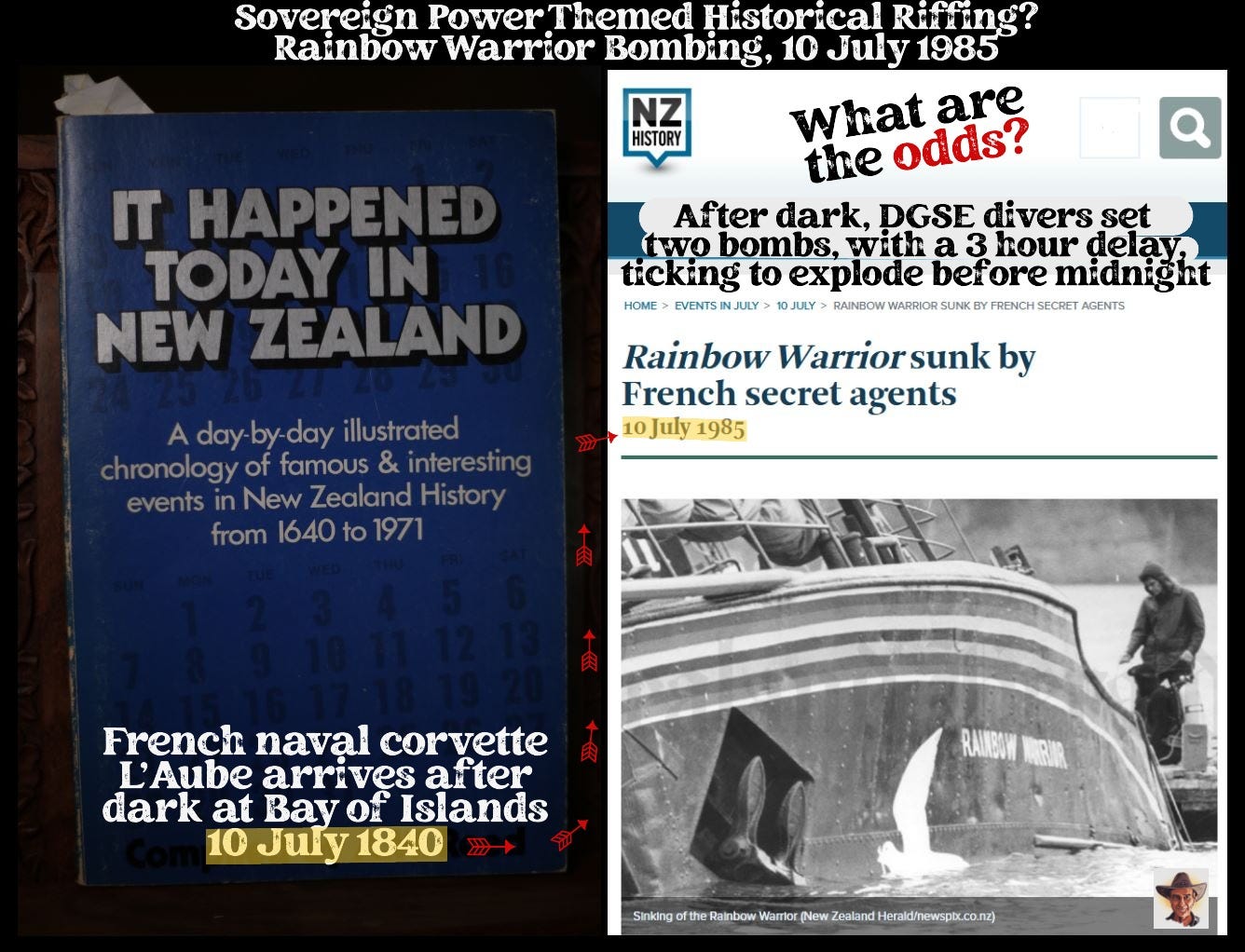
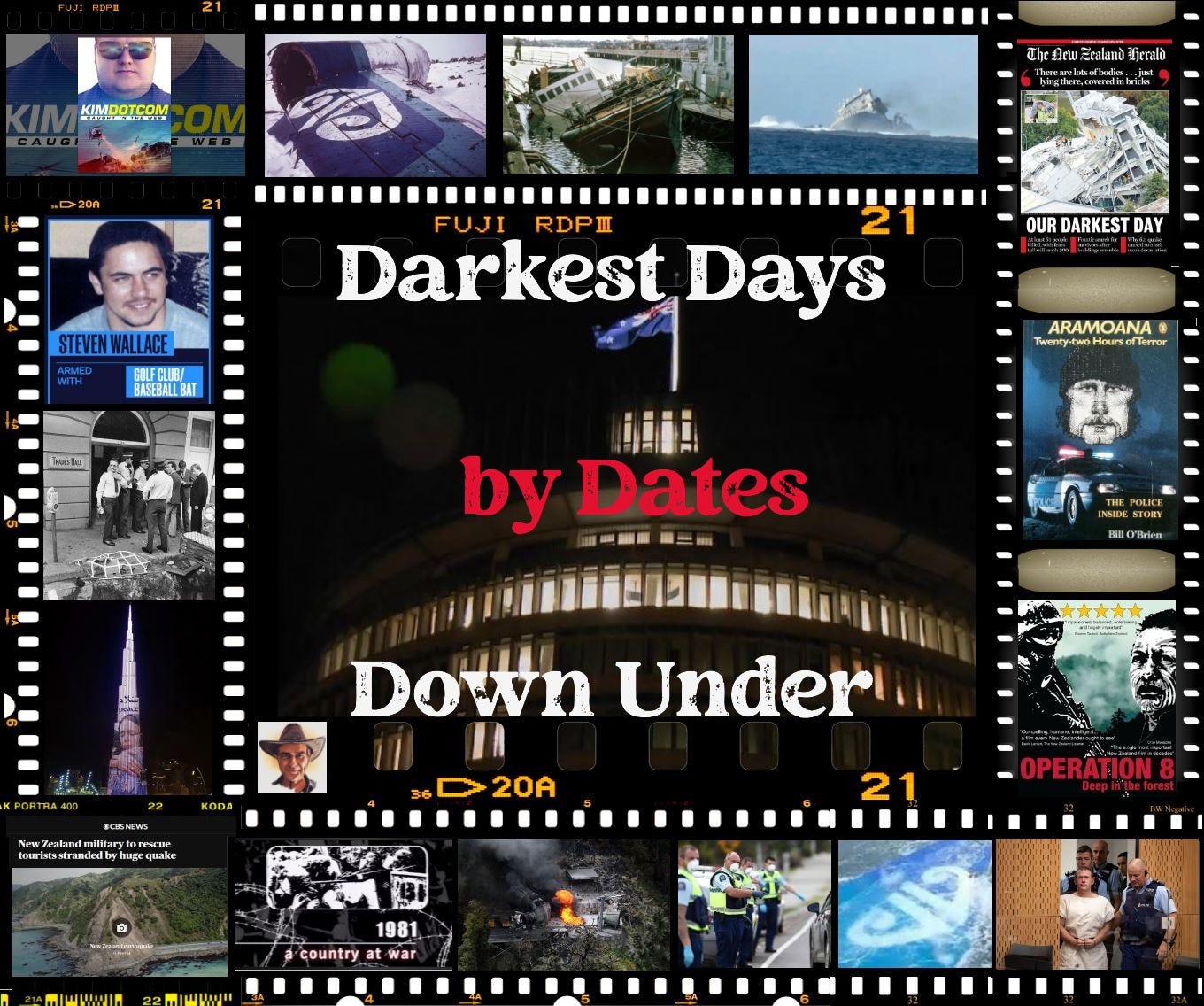


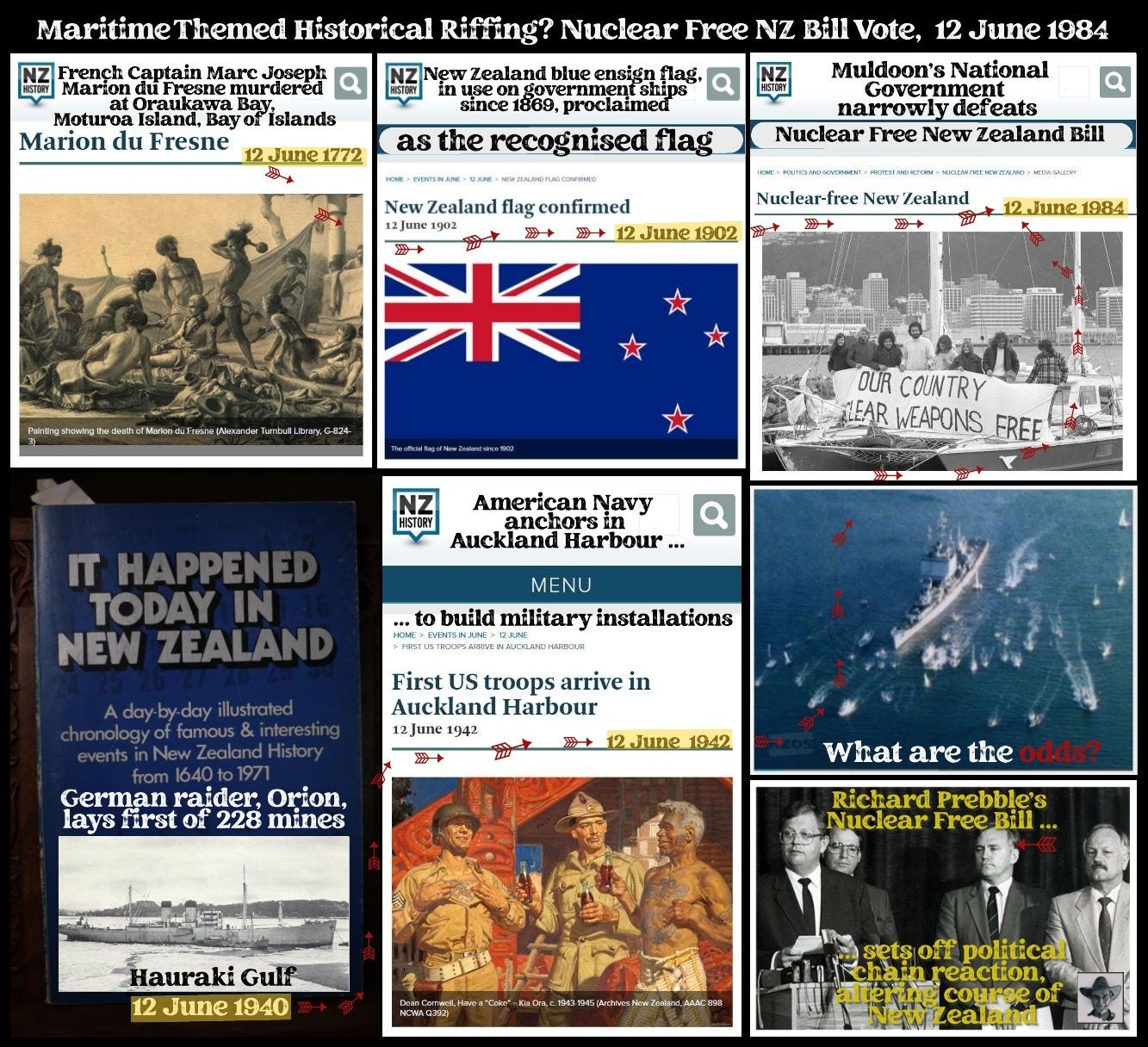
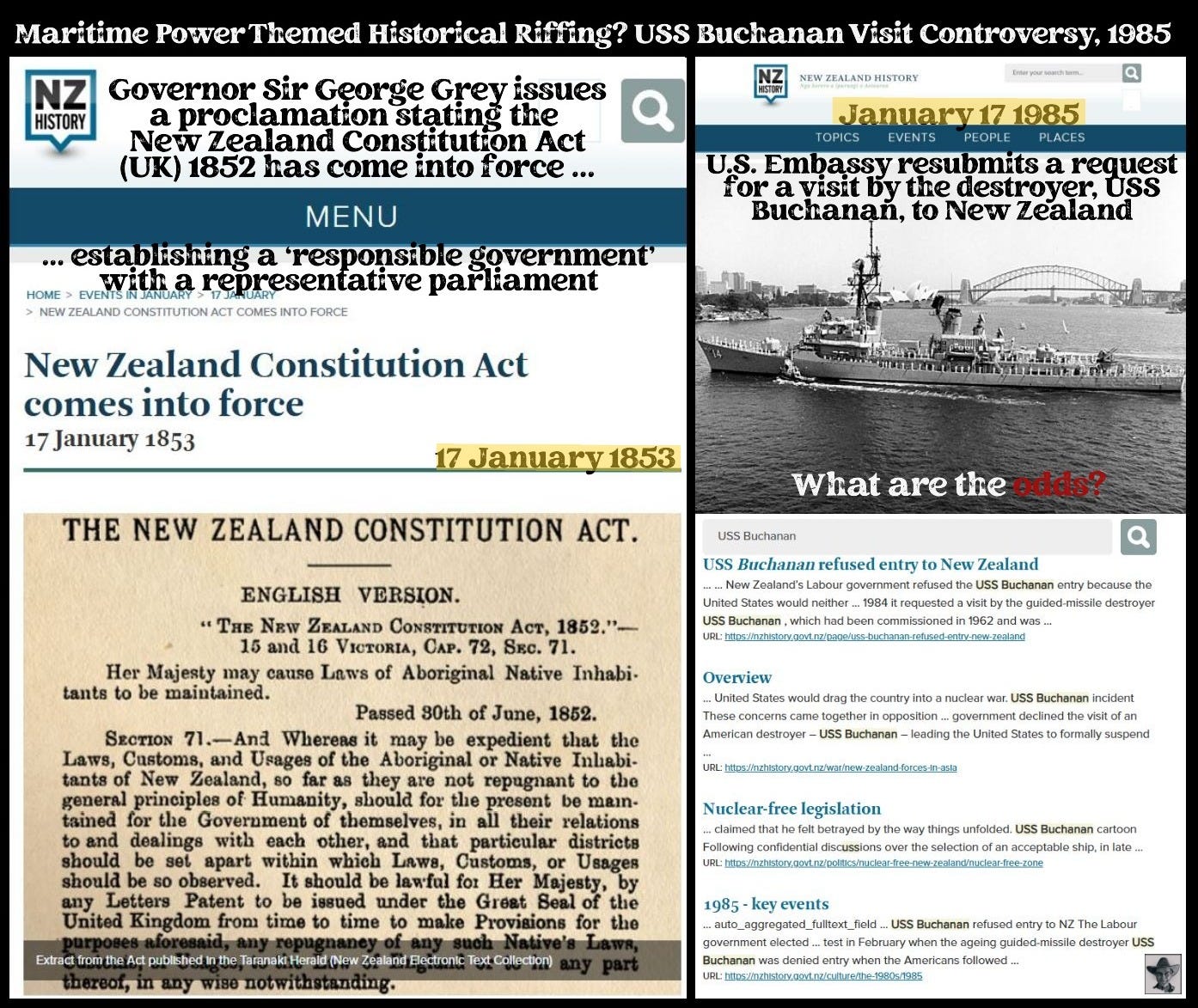
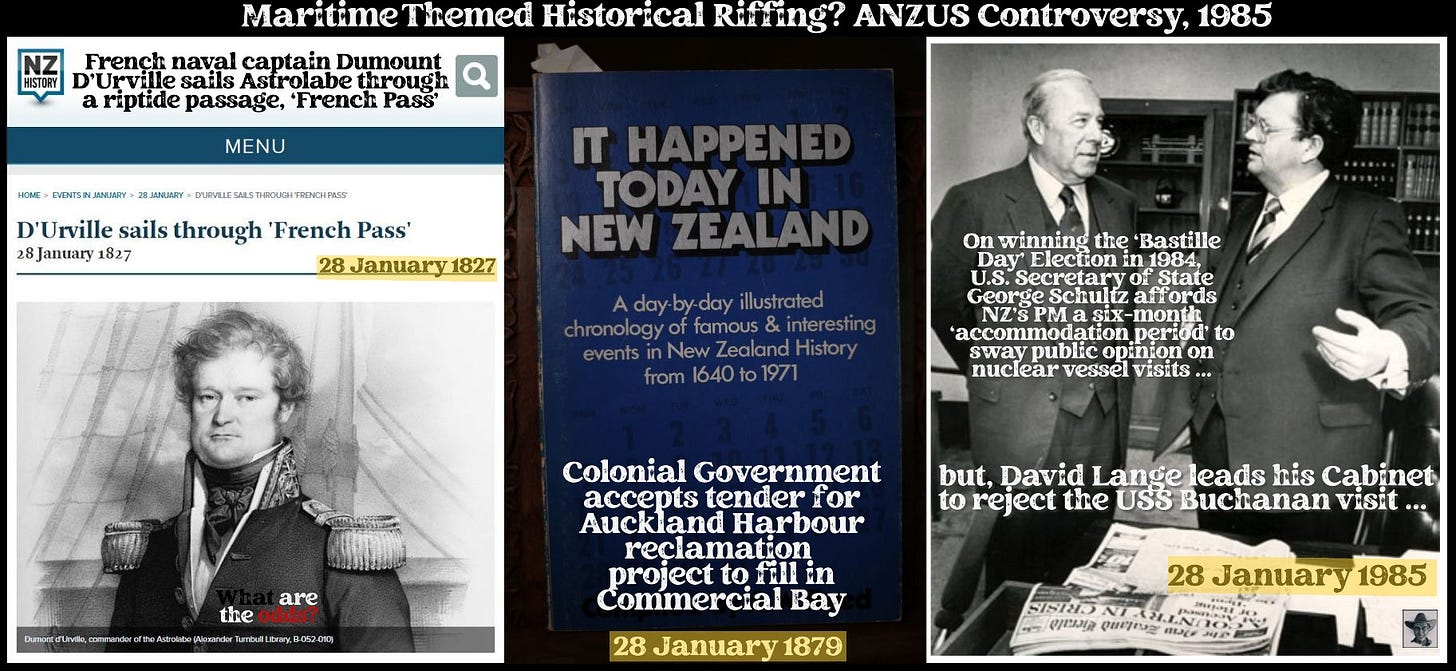
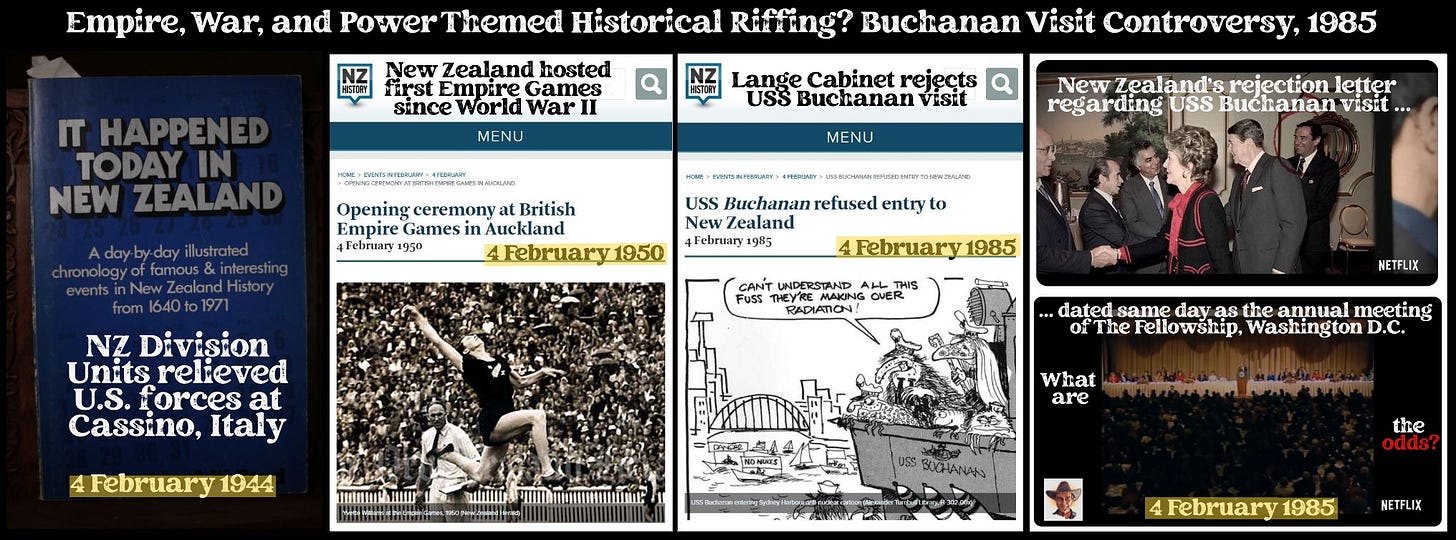
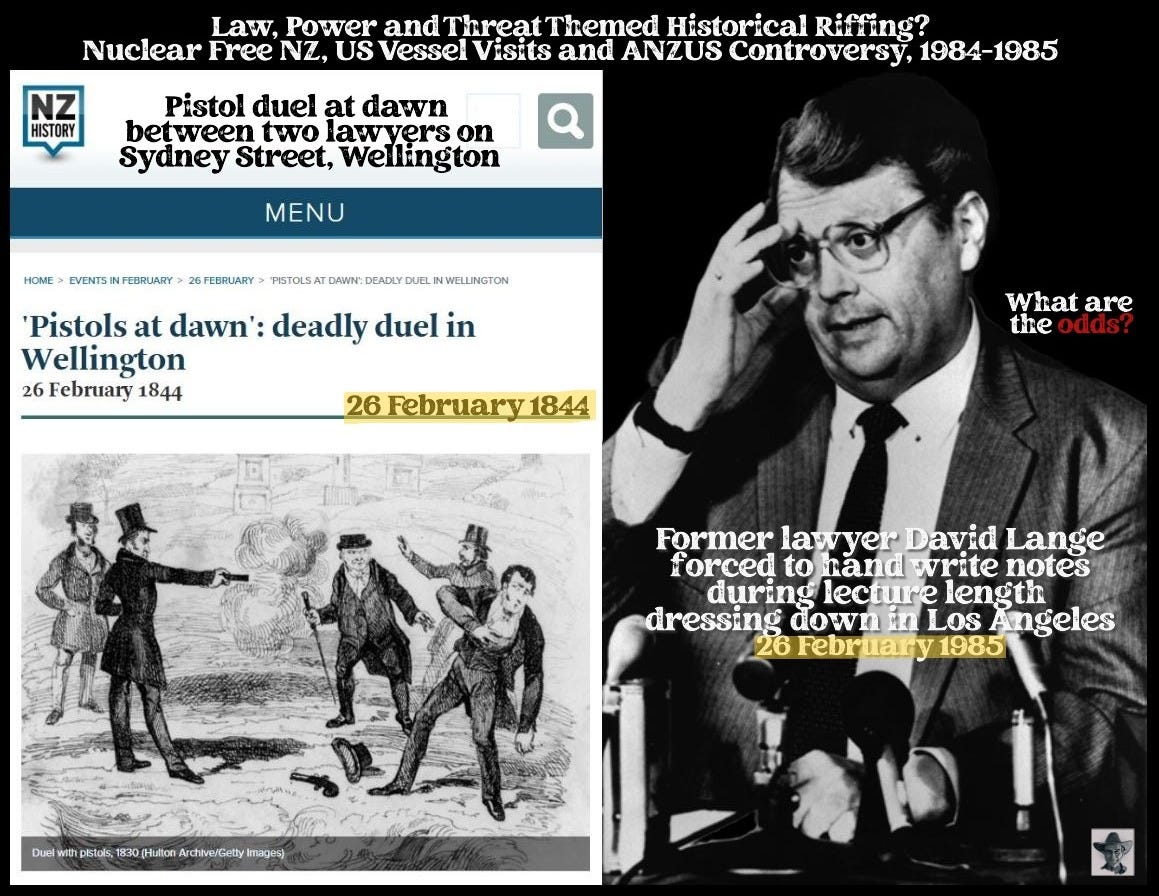
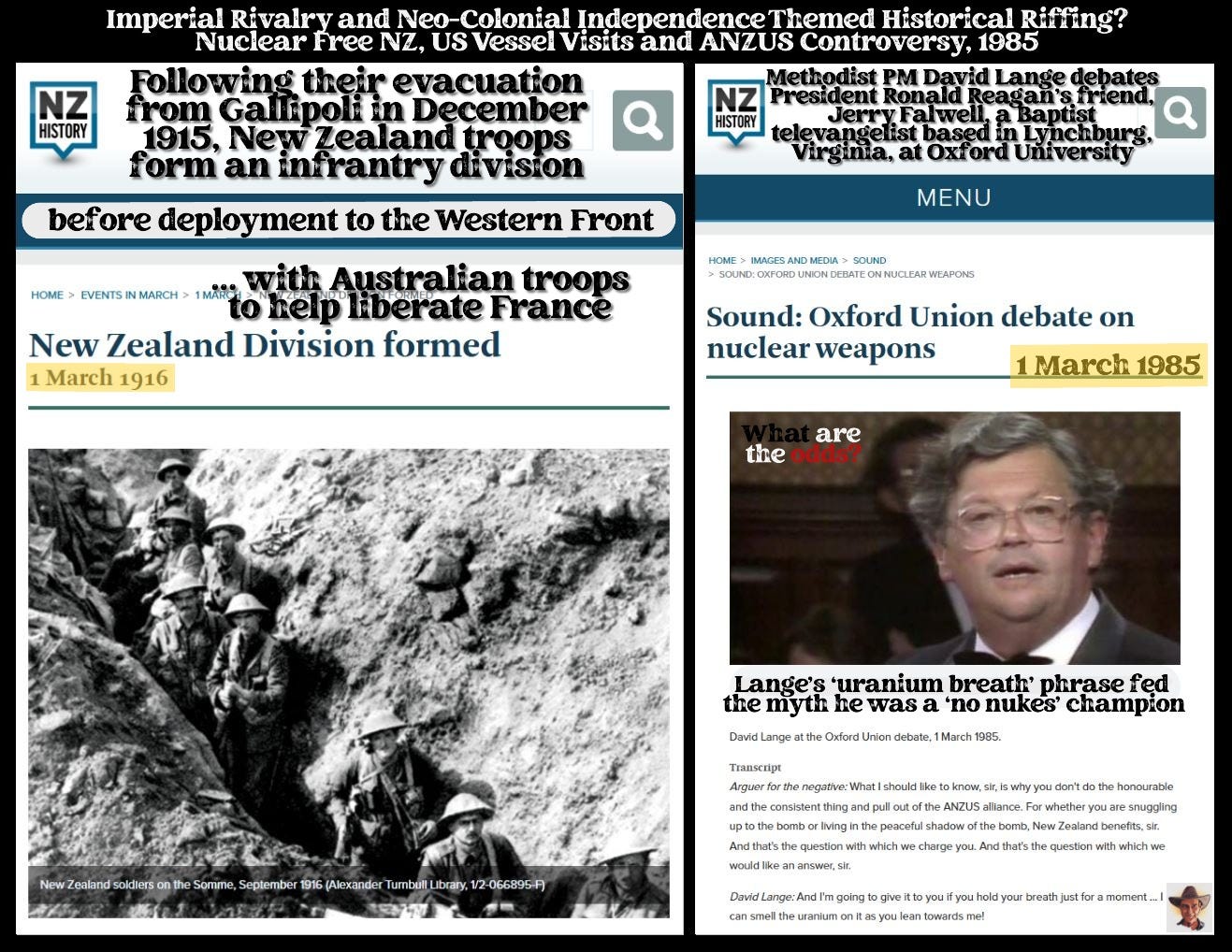
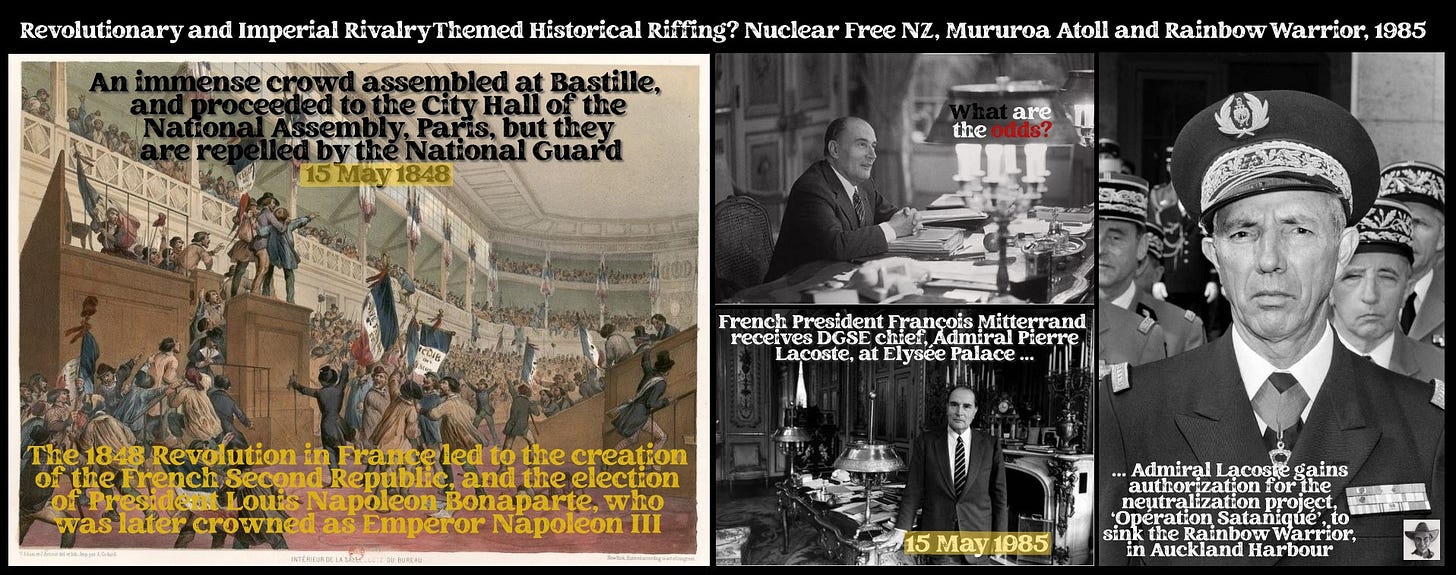
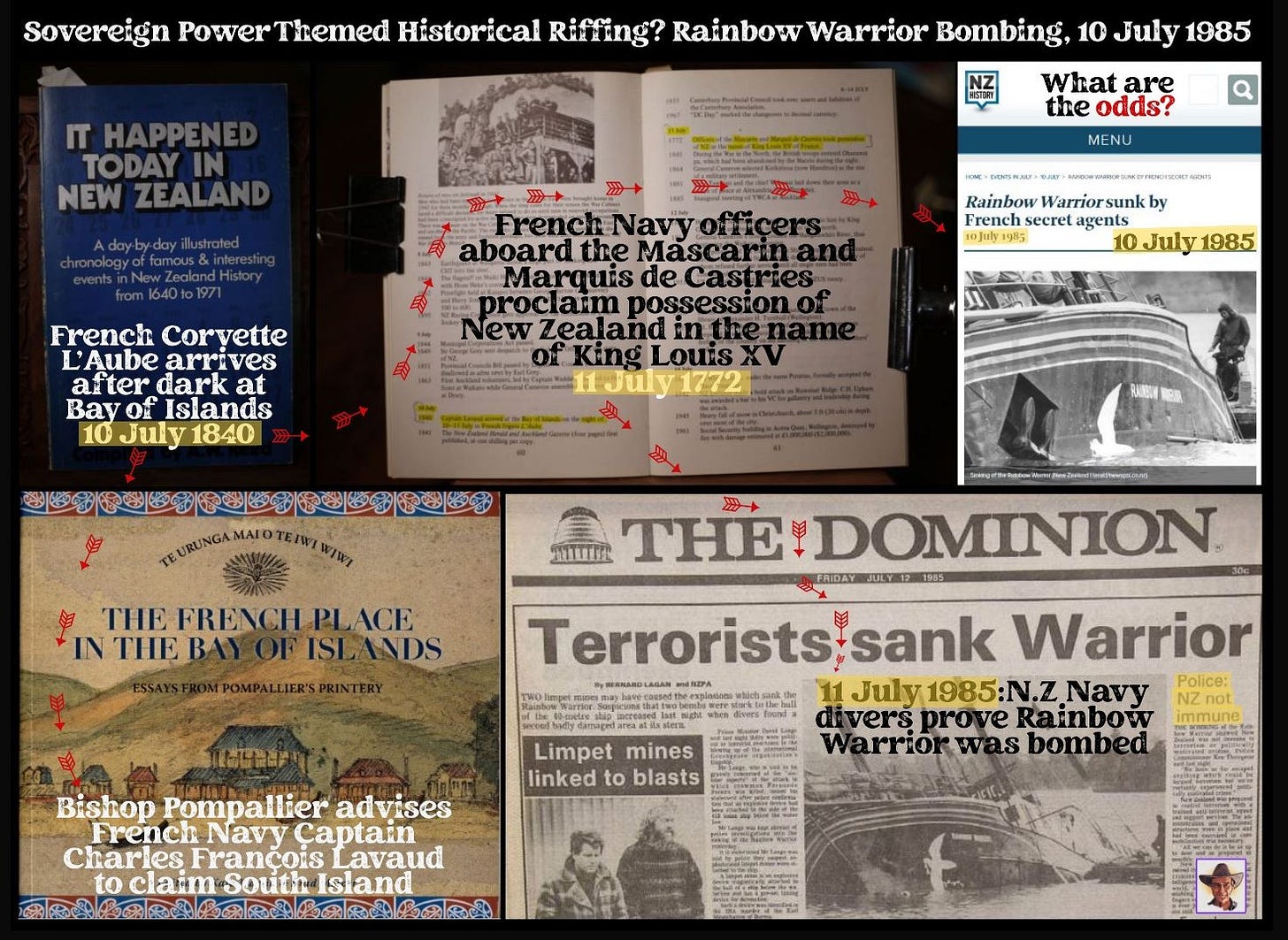

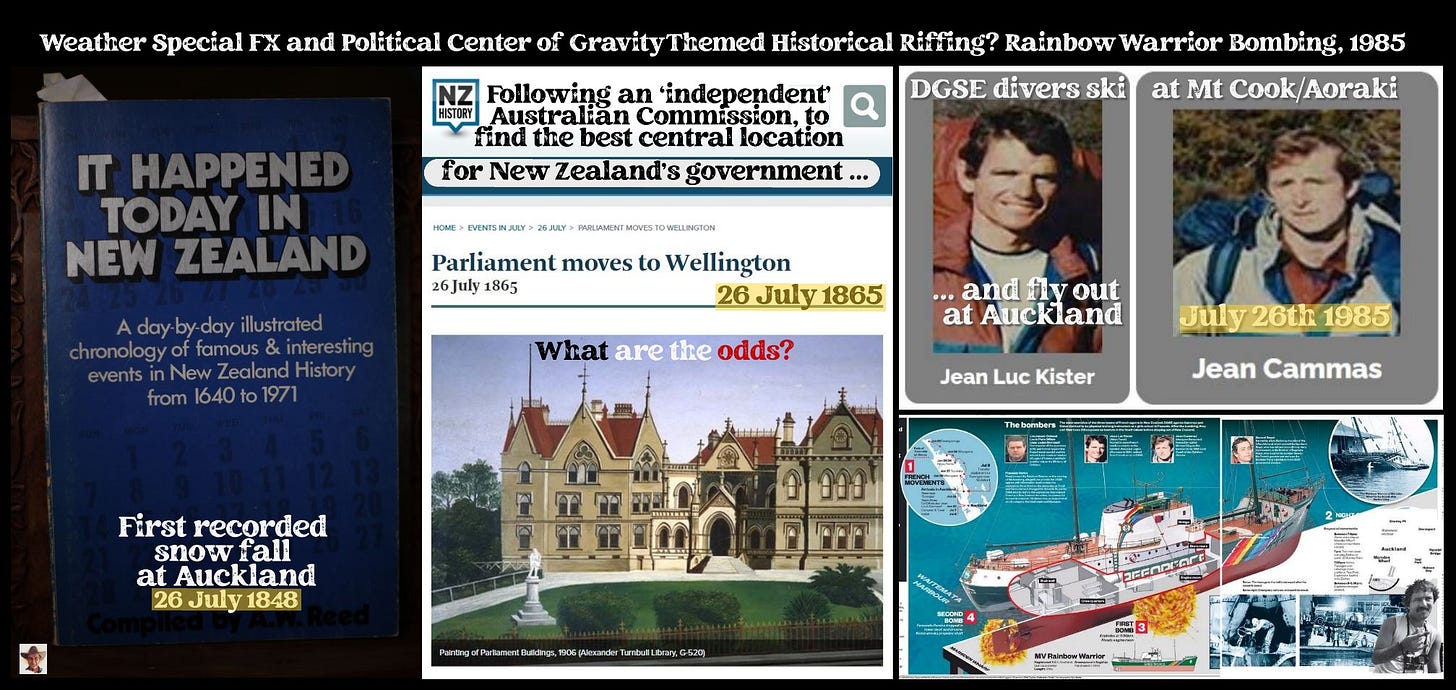
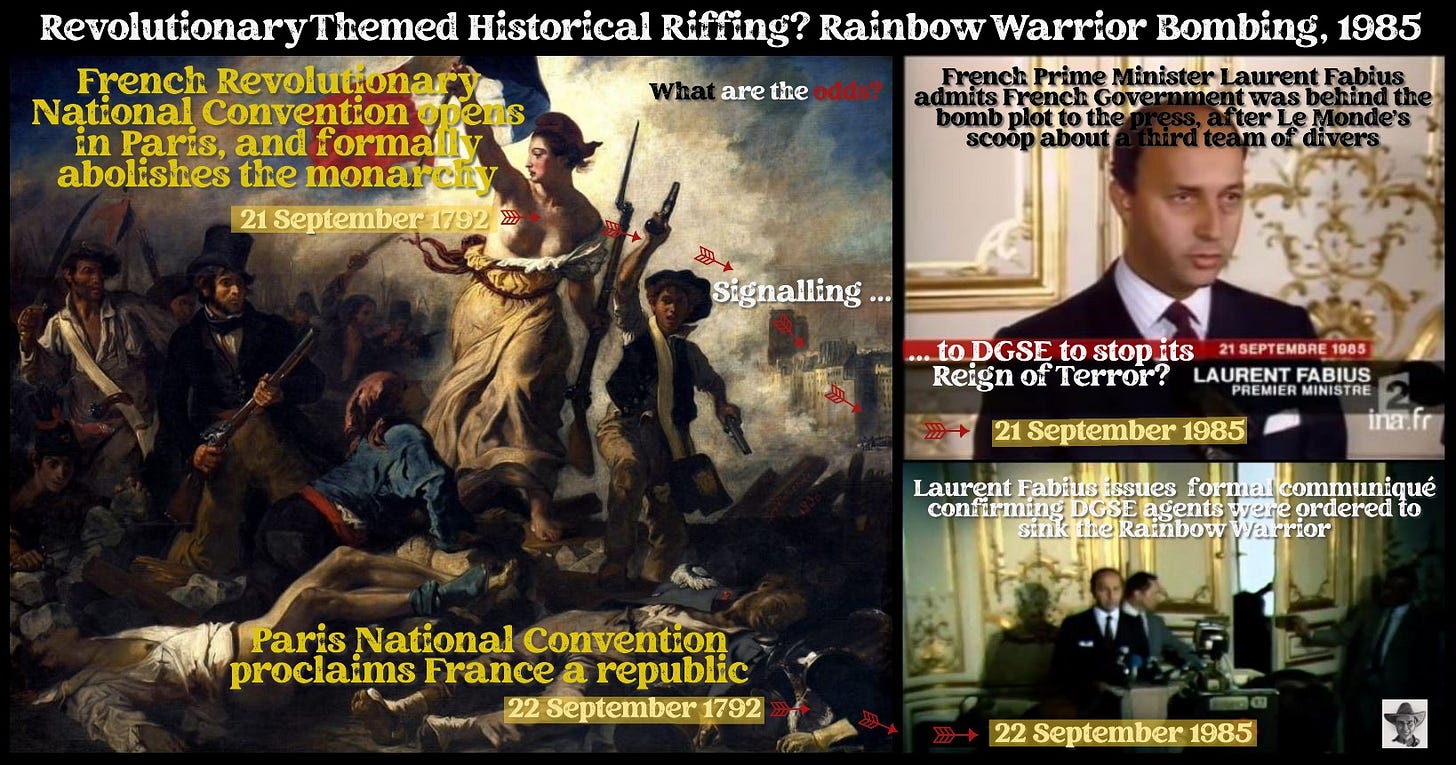
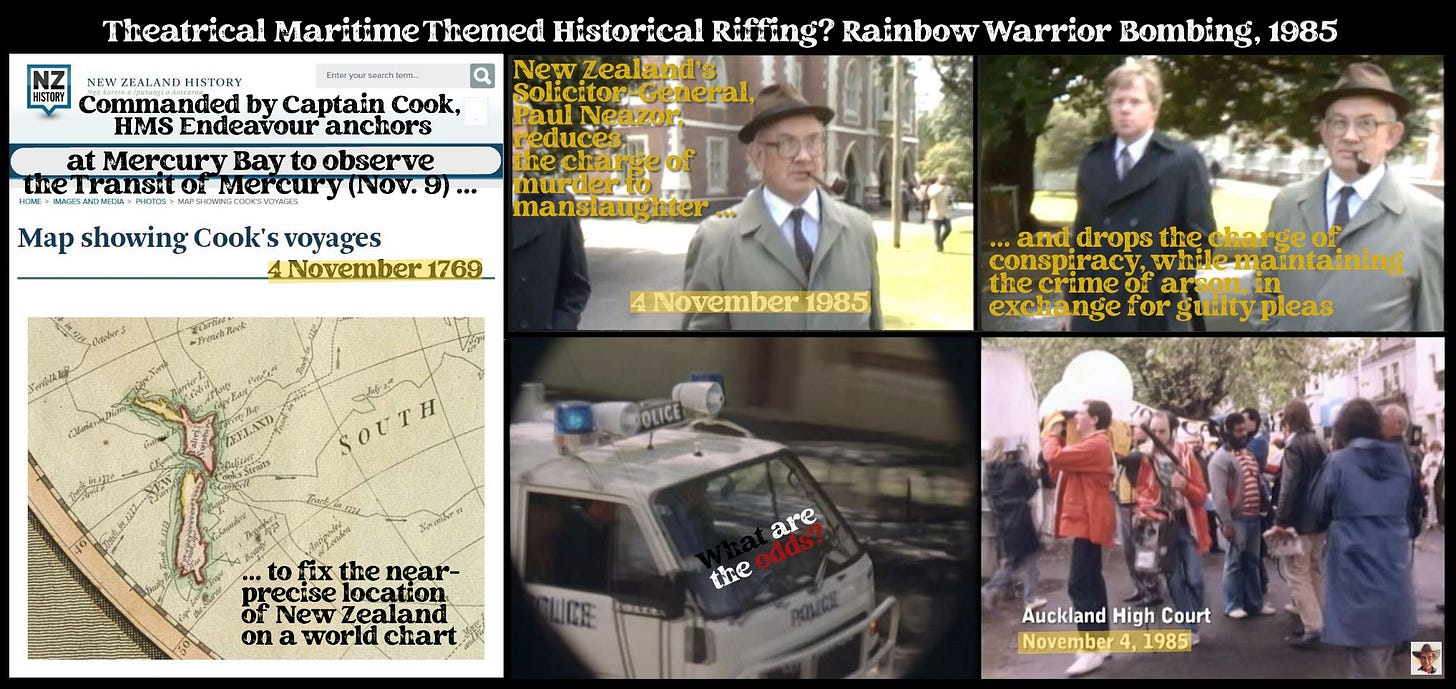
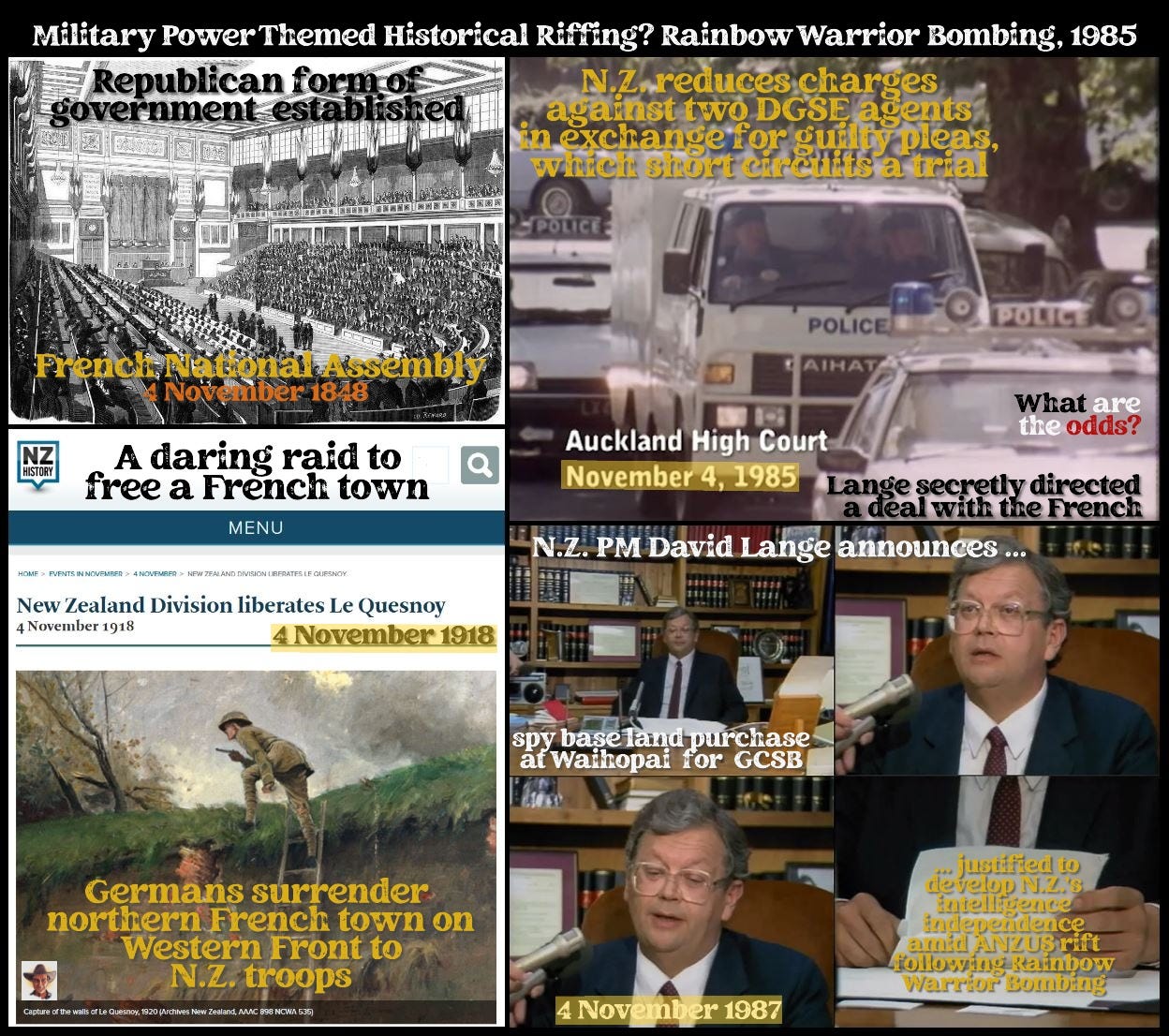
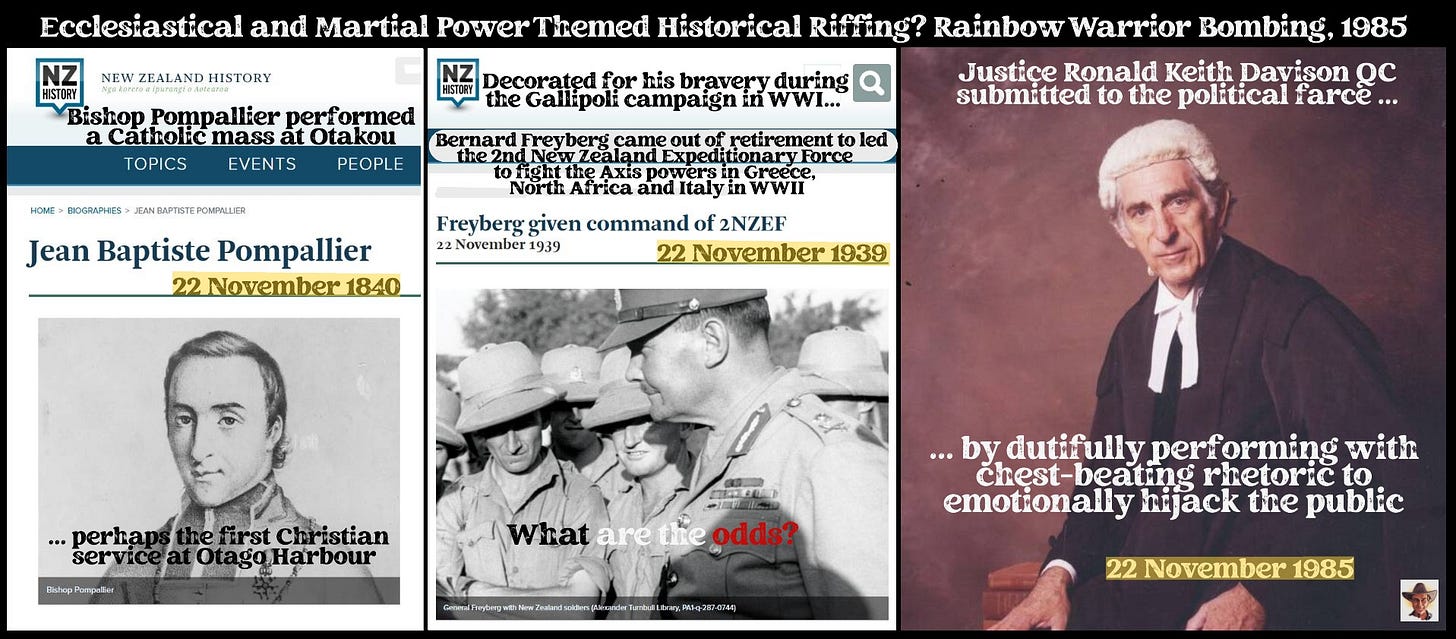
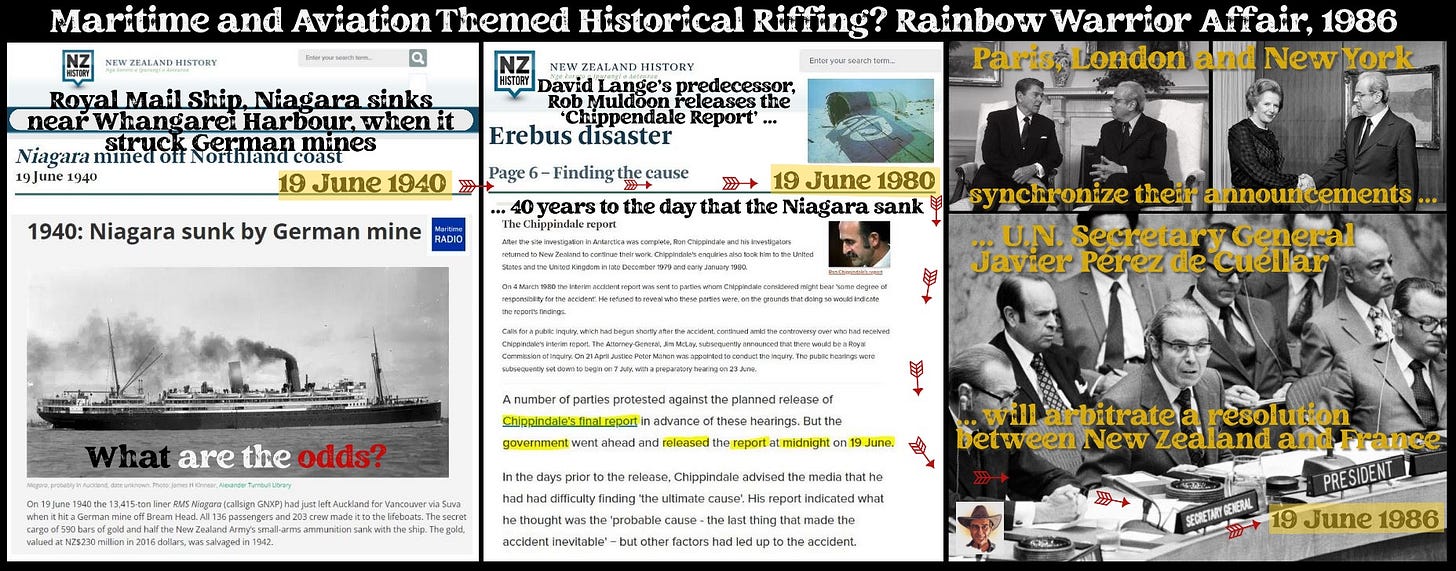
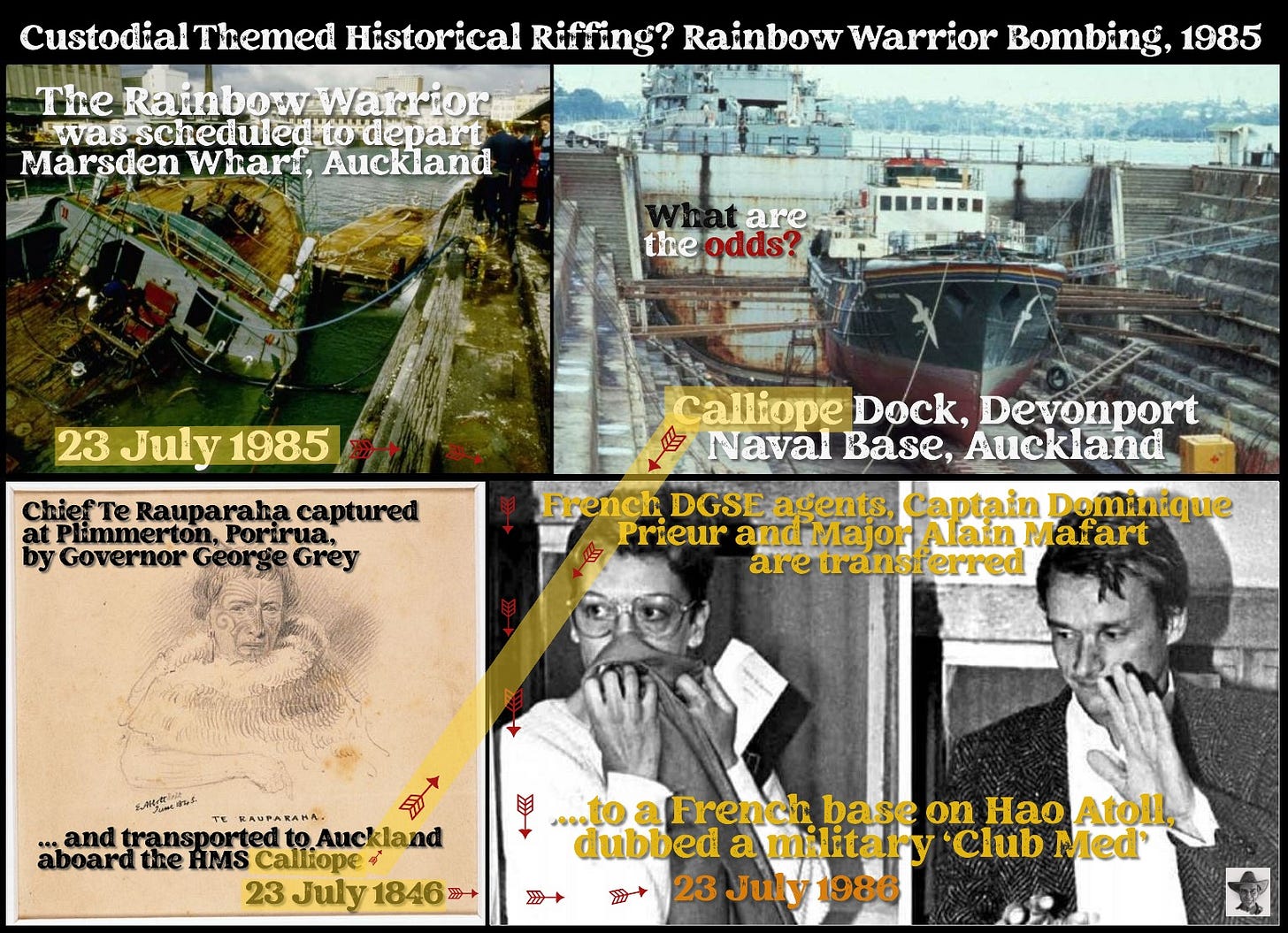
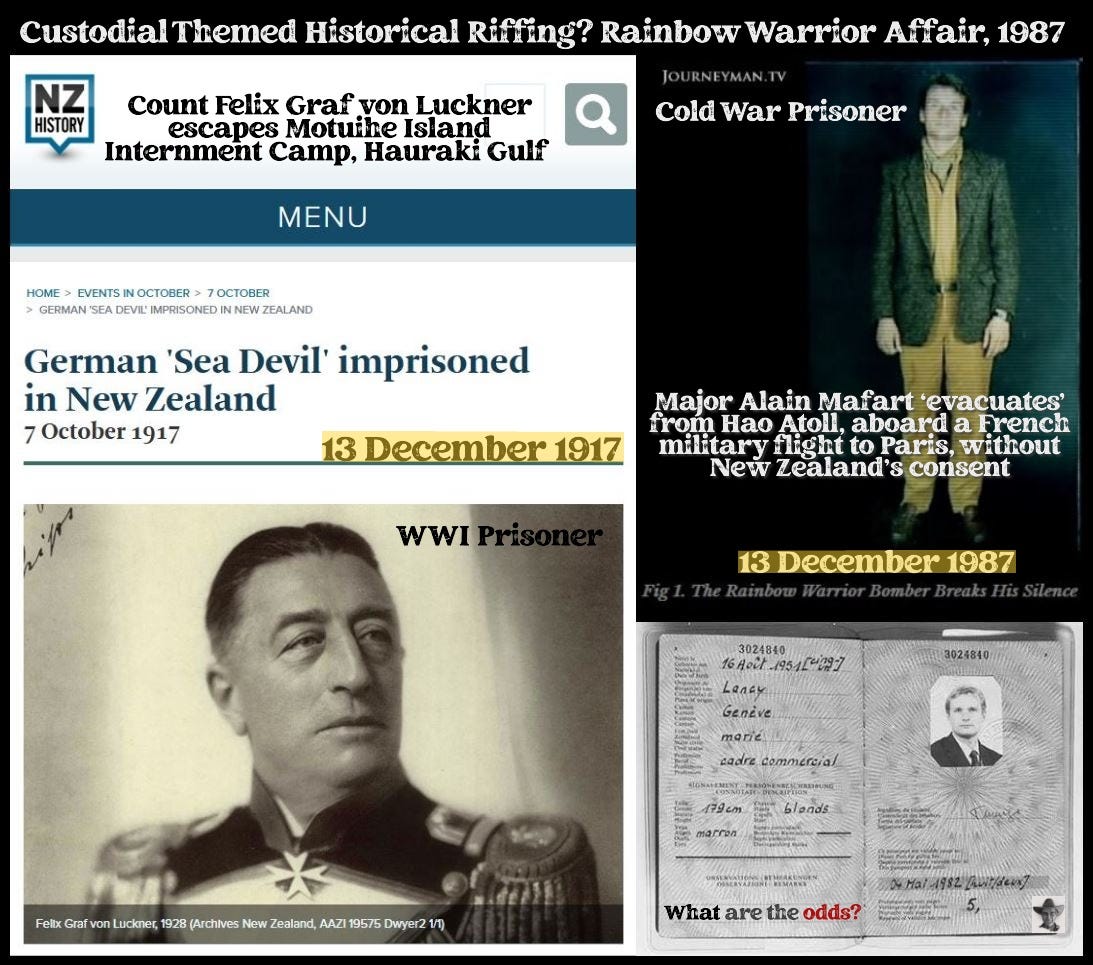
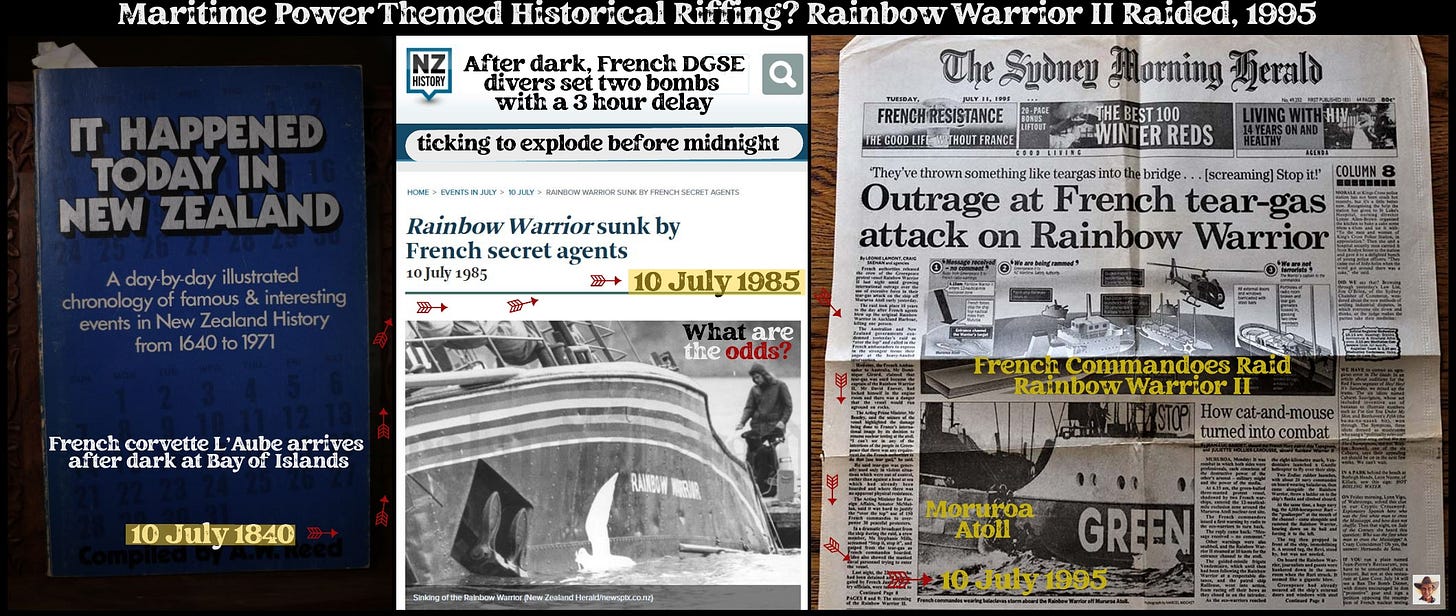

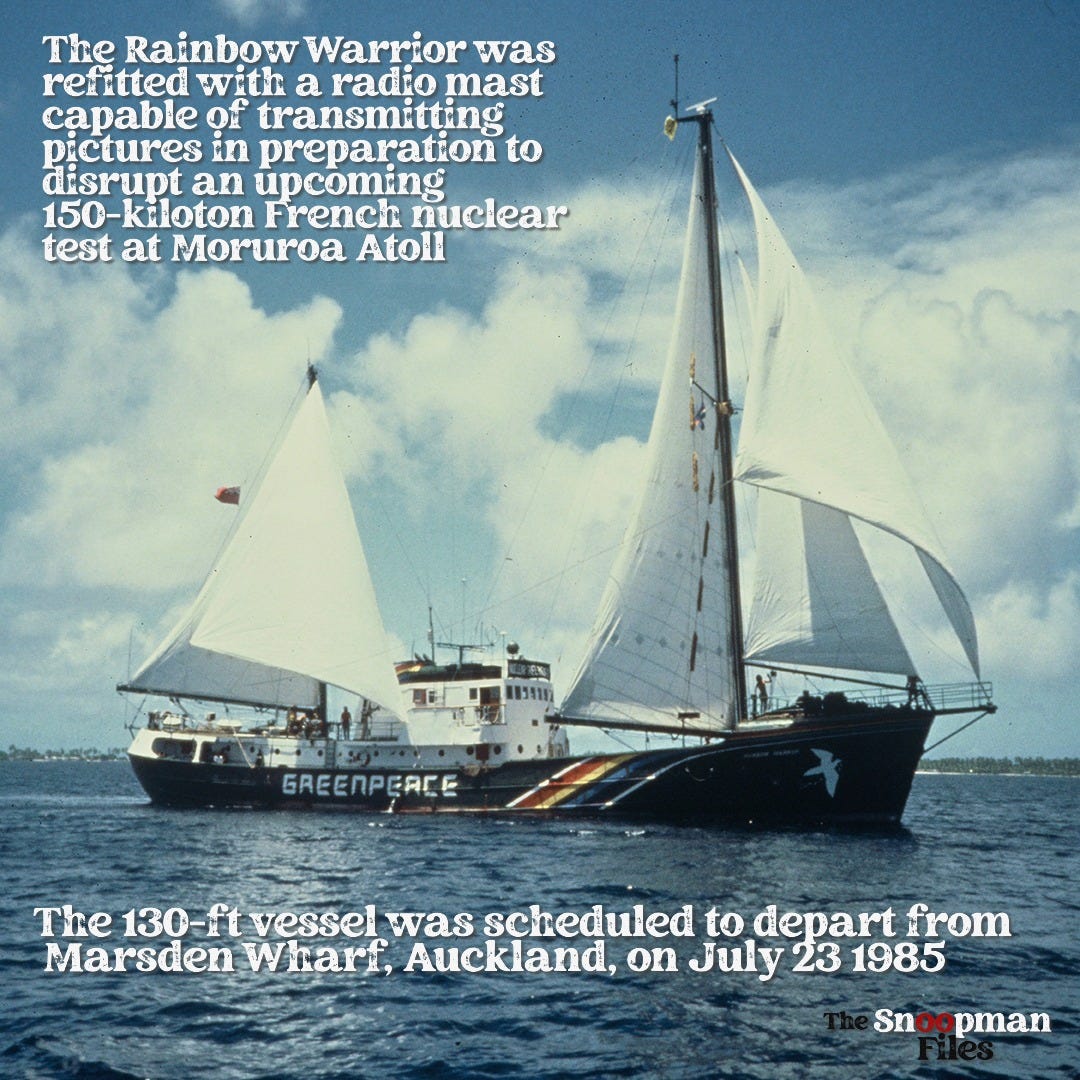
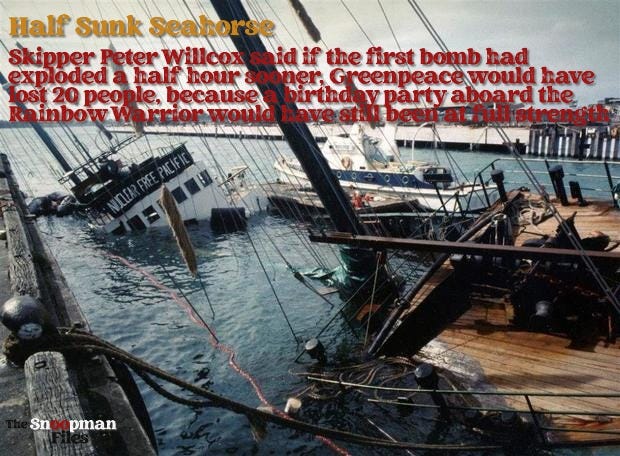
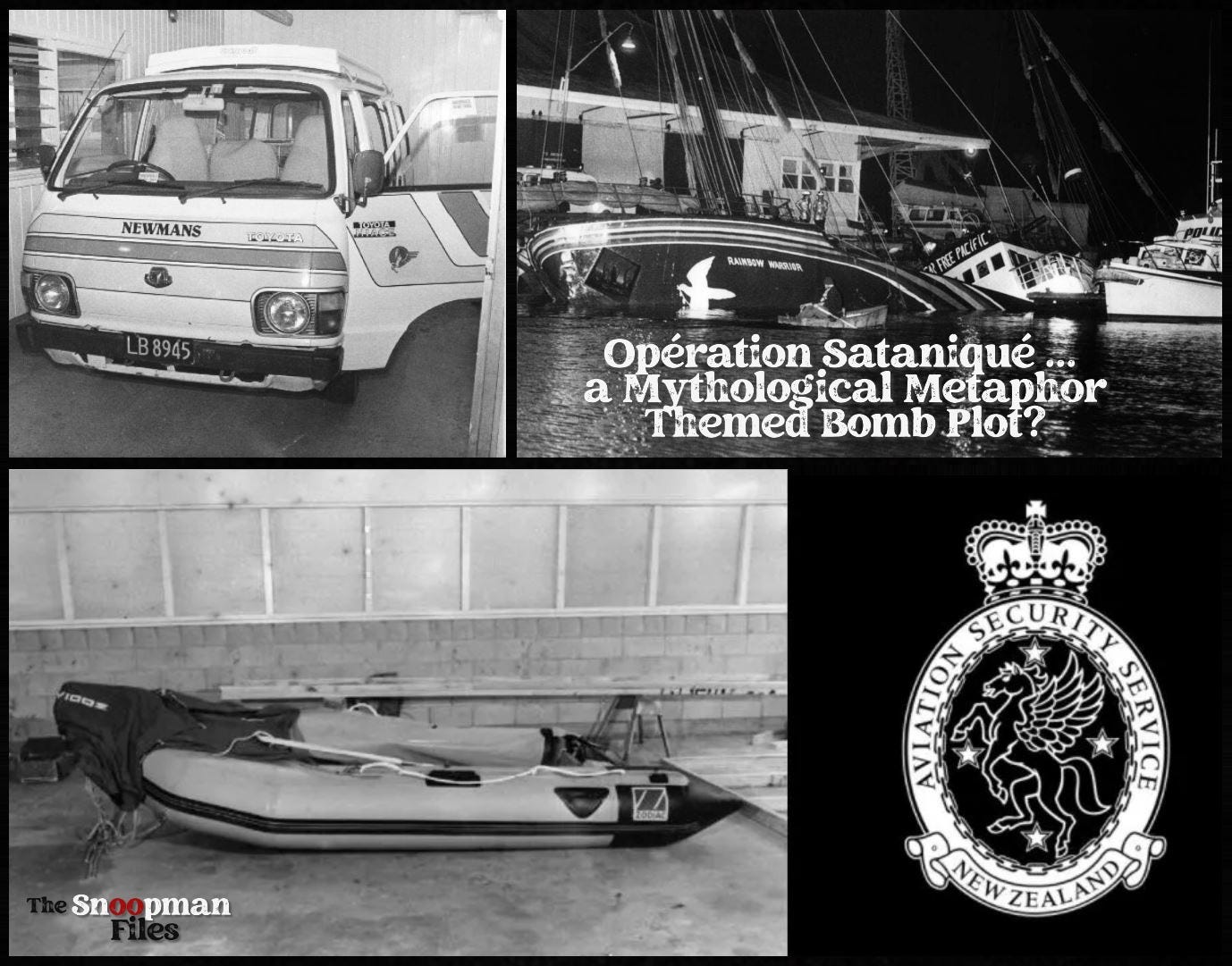
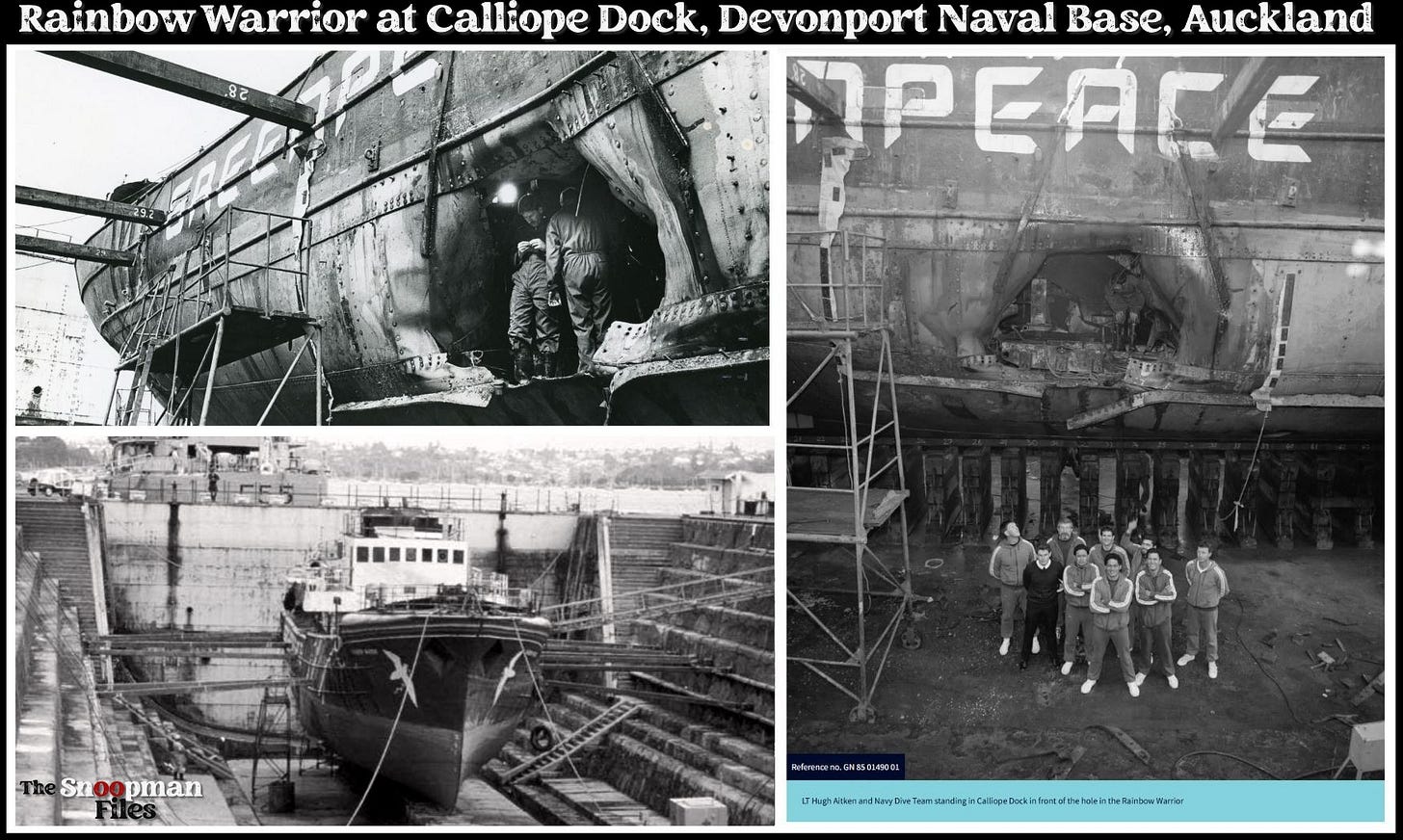
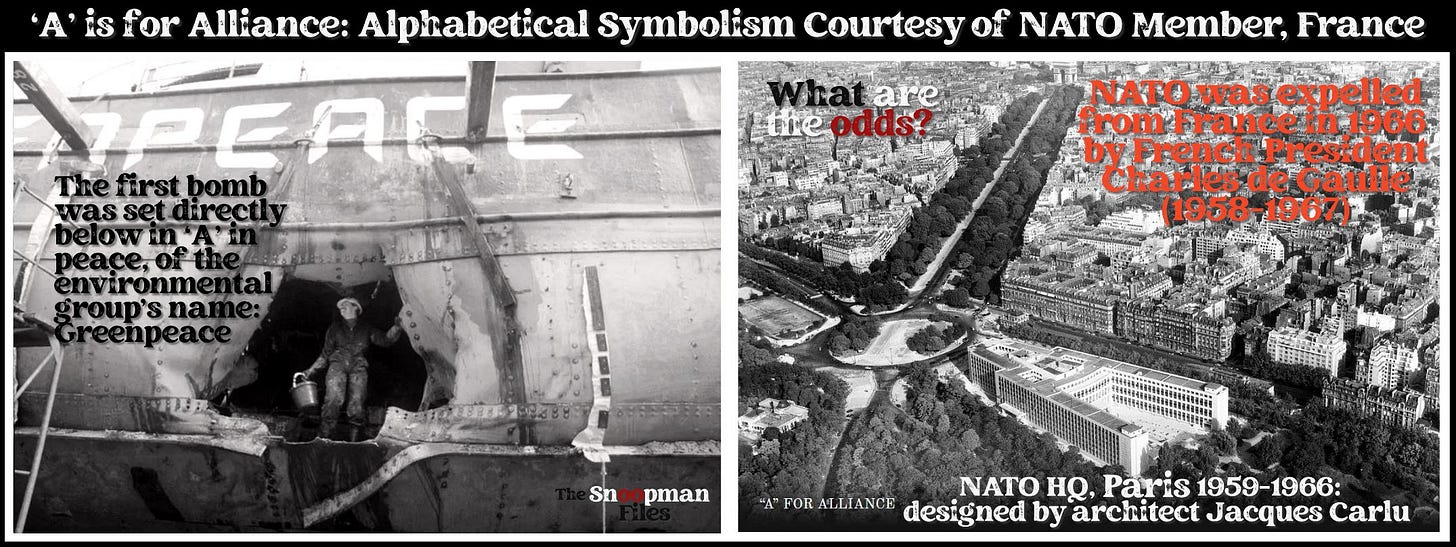
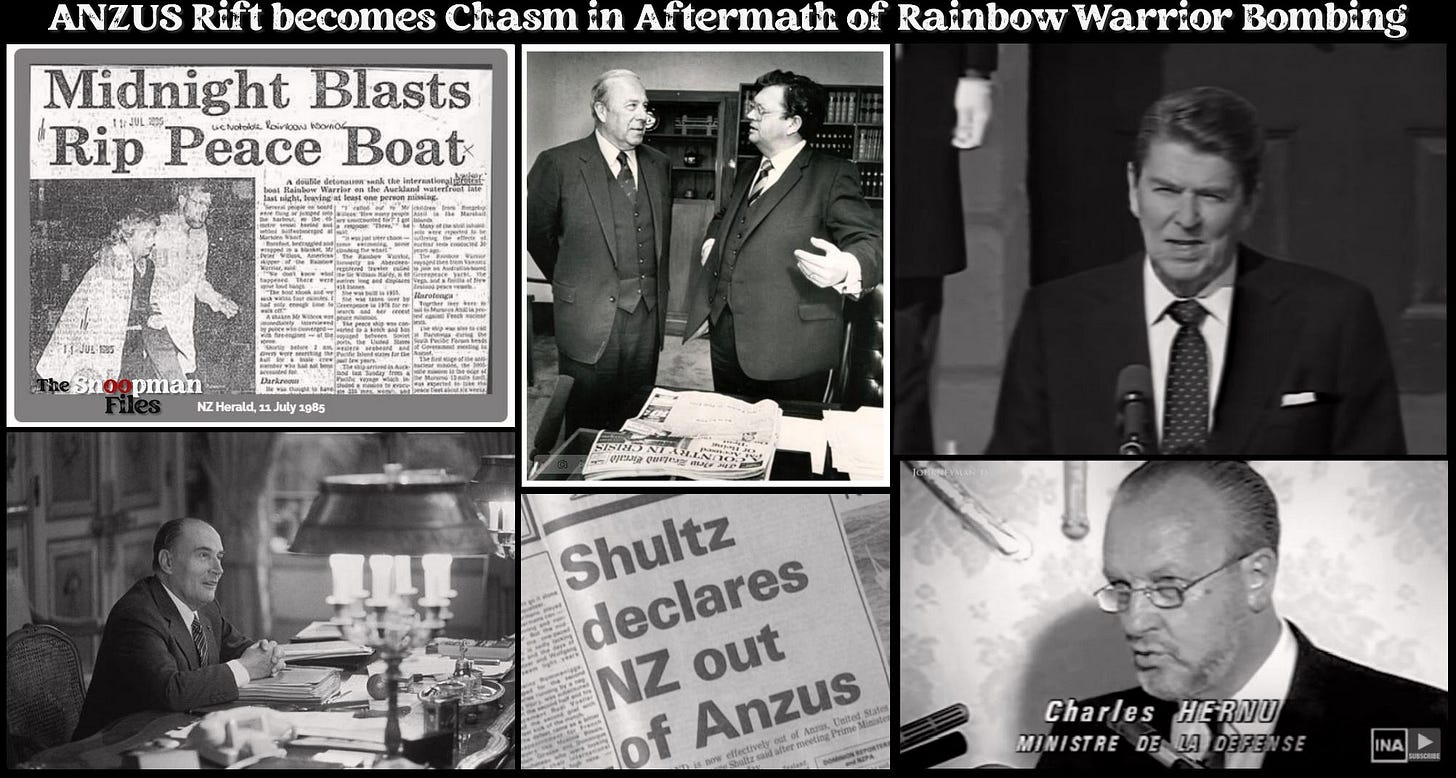

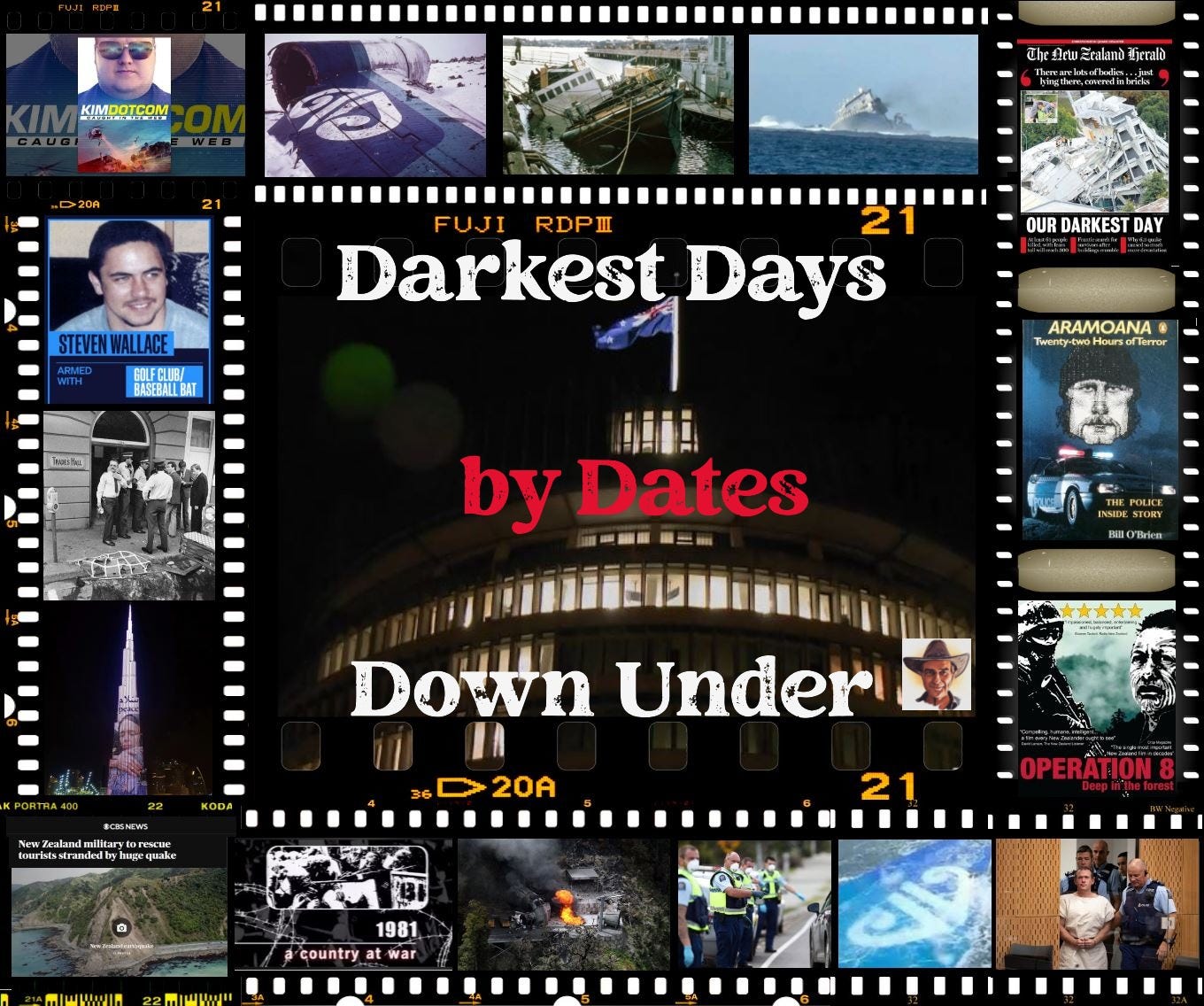

A few more numbers:
"July 10 1985" -- decimal currency was introduced in NZ on July 10 1967.
6+7=13
8+5=13
In astrology, the number 13 is linked to the "Death" Tarot card; symbolizes the end of a struggling period and the beginning of a new one. It represents the death of the old and the birth of the new, marking a significant change and transformation.
Another good and detailed analysis.
Aside: 1. I see Bob Jones died the other week.
2. I take it you've read Gerald Hensley's Final Approaches memoir.
wow those numbers just keep coming up don't they